Who was your father?
Edward Hallock Mills and Mary Ann Pine were married on 29 Dec 1850 in Hempstead NY by Reverend Nathaniel Clark Locke of Christ’s First Presbyterian Church of Hempstead. Reverend Locke deserves closer examination owing to several intriguing coincidences between his life and the Mills’ that may provide context for the Mills’ move to Corfu NY.
I have labored to rescue from oblivion the names of those who have gone before us, to record their virtues, and to place landmarks where they resided; that those of us who are now on the stage, and those that come after us, may answer the question–”Who was your father?”
— 01 Jan 1853, John Goodwin Locke, “To My Kinsfolk”, Book of the Lockes: A Genealogical and Historical Record of the Descendants of William Locke, of Woburn., James Munroe and Company, Boston MA, p3, Archive.org.
In 1837, 18 year old Edward Hallock Mills moved with his parents to an area in Hempstead known then as Trimming Square and today as Franklin Square. In Hempstead, Edward met his mentor in the grocery business, Charles M. Pine, and Charles’ younger sister, Edward’s first wife, Mary Ann (Pine) Mills (08 Feb 1819 to 28 Dec 1895).
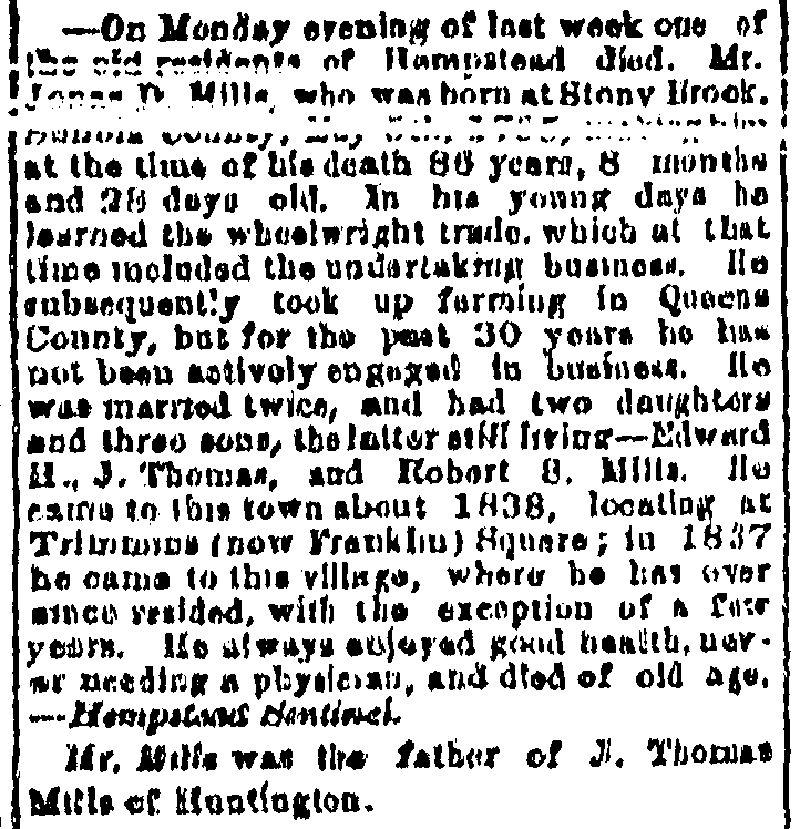
—On Monday evening of last week one of the old residents of Hempstead died. Mr. Jonas D. Mills, who was born at Stony Brook, [Suffolk County?], May [unclear day and year], making him at the time of his death, 86 years, 8 months, and 28 days old. In his young days he learned the wheelwright trade, which at that time included the undertaking business. He subsequently took up farming in Queens County, but for the past 30 years he has not been actively engaged in business. He was married twice, and had two daughters and three sons, the latter still living—Edward H., J. Thomas, and Robert S. Mills. He came to this town about 1838, locating at Trimming (now Franklin) Square; in 1837 he came to this village, where he has ever since resided, with the exception of a few years. He always enjoyed good health, never needing a physician, and died of old age.
—Hempstead Sentinel
Mr. Mills was the father of J. Thomas Mills of Huntington.
— 10 Feb 1882, The Long-Islander, Huntington NY, p3, nyshistoricnewspapers.org. View largest available size.
Charles Pine’s grocery store was established in 1848 in “Factoryville” an old, colloquial name for the neighborhood later called West New Brighton in Castleton, one of the original four towns of Staten Island. At least by 1850, Edward was living in Factoryville, presumably working in Pine’s store, and possibly living in Pine’s home next to the store, as other store clerks were known to do.
Edward returned to Hempstead to marry Mary Ann Pine on 29 Dec 1850 at First Presbyterian Church, officiated by Reverend Nathaniel Clark Locke (01 Jun 1815 to 21 Jul 1862).

At Hempstead, L. I., Dec. 29, by the Rev. N.C. Locke, Mr. Edward H. Mills of Factoryville, S. I., to Miss Mary Ann Pine of the former place.
N.Y. Sun please copy.
— 03 Jan 1851, The Brooklyn Daily Eagle, Brooklyn NY, p2, newspapers.com. View largest available size.

1850.
Mar. 7. Charles T. Ruland and Ann Catherine De Mott.
Marriages BY Rev. N. C, Locke.
Dec. 29. Edward H. Mills of Staten Island to Mary Ann Pine.
— 1922, History and Vital Records of Christ’s First Presbyterian Church of Hempstead, Long Island, New York, Contributed by John Dean Fish, The New York Genealogical and Biographical Record, Volume 53, p256, Google Books. View largest available size.
Both the Mills and Pines attended Christ’s First Presbyterian Church in Hempstead. Many other family names can be found in the Church’s records that are either relatives of Mills and Pines or otherwise connected with them, including Seaman, Gildersleeve, Higbie, Weekes (also Weeks), Hawkins, Bedell and Mersereau. It is perhaps relevant that the surname “Watts” is also present and may provide context for understanding Edward’s nephew’s middle name (which he commonly went by).
The history of Christ's First Presbyterian Church is closely identified with the history of Hempstead. In 1643, the Rev. Robert Fordham and John Carman found a suitable location for settlement here and purchased land from the Native Americans. Families came to settle the next year. They received a patent from the Dutch governor of the New Netherlands and the church was organized under Rev. Richard Denton. Rev. Denton had first settled in the Massachusetts May Colony, but left for Weathersfield, Connecticut in 1635 in order to practice Presbyterianism. Later, he and his followers came to Long Island for religious reasons. They established Christ's First Presbyterian Church in 1644. It is one of the oldest Presbyterian Churches in the country.
The Church has had several structures over the years, but the longest serving structure was built in 1846 and used until 1969.
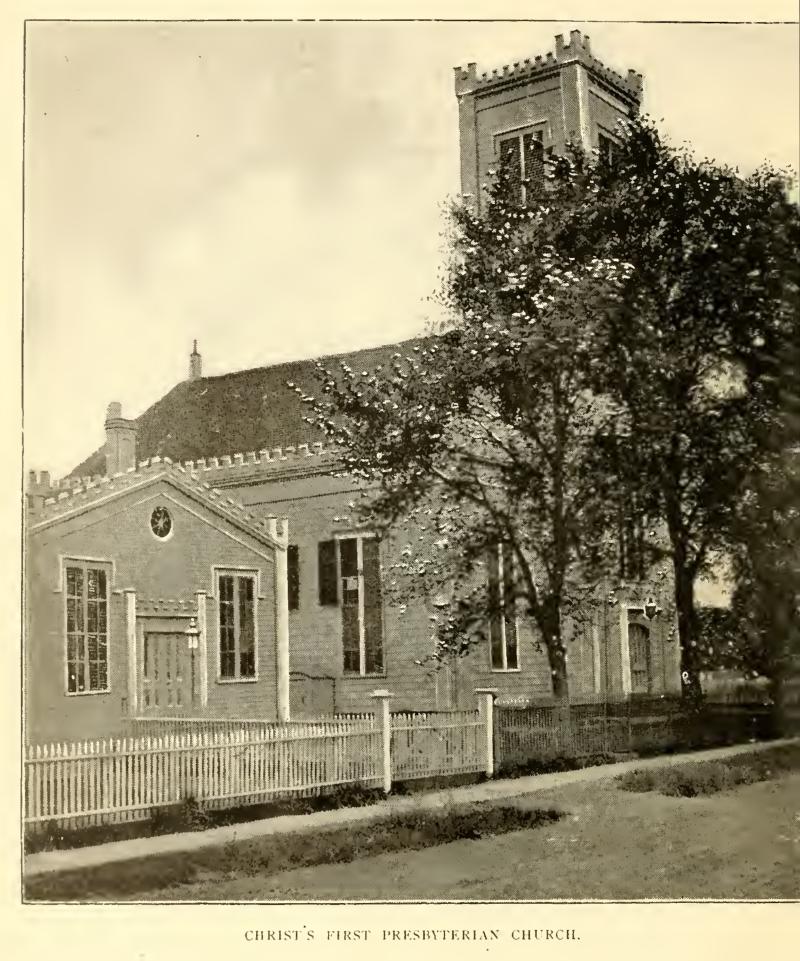
Christ’s First Presbyterian Church.
— 1895, Souvenir of the 250th Anniversary of Christ’s First Presbyterian Church: Hempstead, Long Island, N.Y., October 14, 15, 16, 1894, archive.org. View largest available size.
Note that in the following photograph, the trees in front of the Church appear to be the same trees in the image above, and judging by their relative growth, the following photograph was likely taken a few years later. Notice also that the ornamental trim on the roof line in the above image appears to be missing in the following photograph (except above the door of the smaller structure).
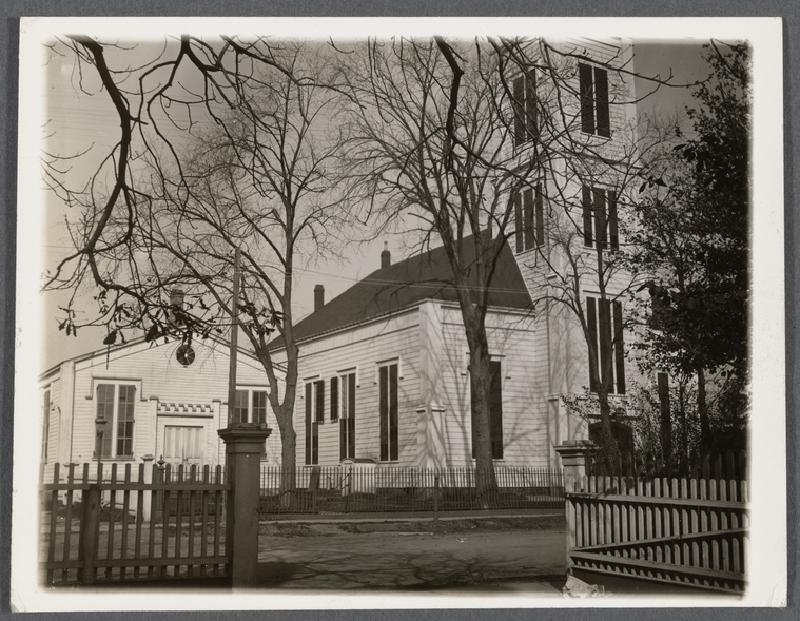
— Irma and Paul Milstein Division of United States History, Local History and Genealogy, The New York Public Library. “Wooden church and chapel on left. Hempstead, Hempstead” The New York Public Library Digital Collections. 1890 - 1930. https://digitalcollections.nypl.org/items/f6d32270-6173-013c-80c6-0242ac110002. View largest available size.
And in the next two photographs, the trim appears missing from the roof line, but the pattern can be seen above the door and along the top edge of the steeple.

— Irma and Paul Milstein Division of United States History, Local History and Genealogy, The New York Public Library. “Wooden church. Hempstead, Hempstead” The New York Public Library Digital Collections. 1890 - 1930. https://digitalcollections.nypl.org/items/f6da1410-6173-013c-c2da-0242ac110002/. View largest available size.
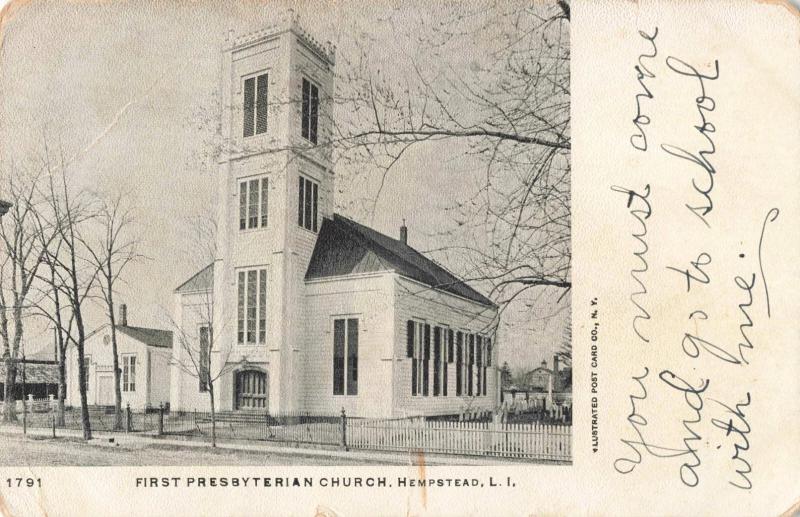
In the following two photos, notice that the both the main entrance and the window configurations on the tower have been structurally changed, which may help date the photographs, as the building was significantly remodeled in 1906:
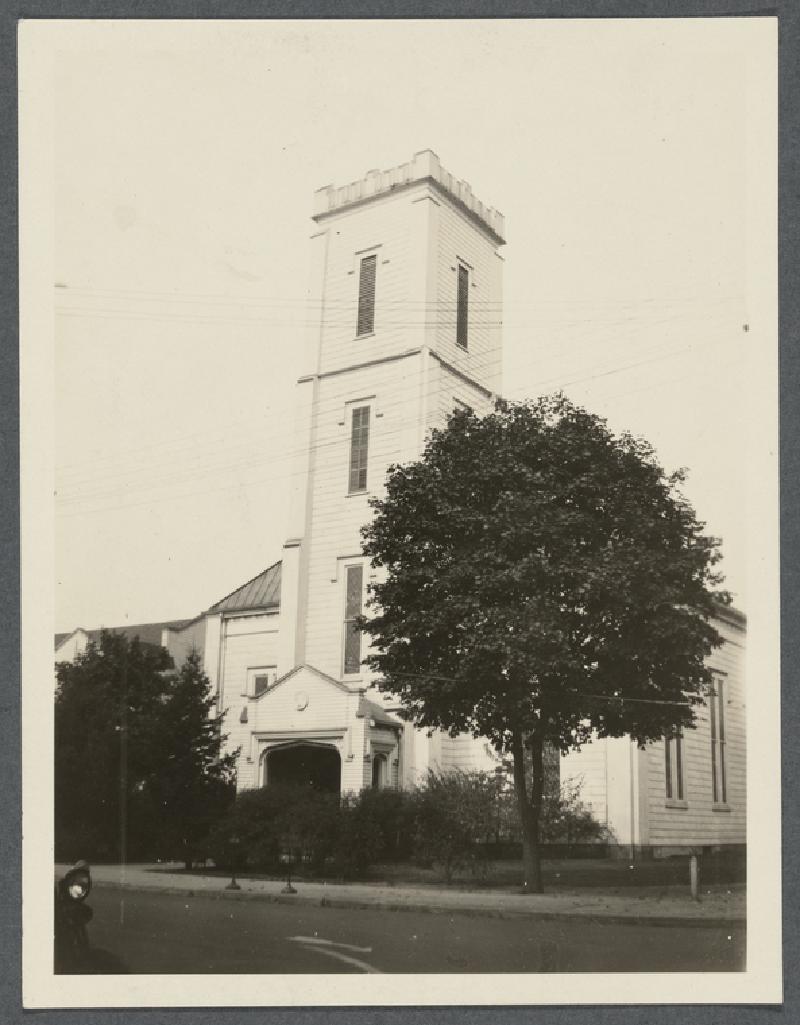
— Irma and Paul Milstein Division of United States History, Local History and Genealogy, The New York Public Library. “Christ First Presbyterian Church. Fulton Avenue, north side near railroad depot. Hempstead, Hempstead” The New York Public Library Digital Collections. 1922. https://digitalcollections.nypl.org/items/647de250-7928-013d-70ba-0242ac110003. View largest available size.
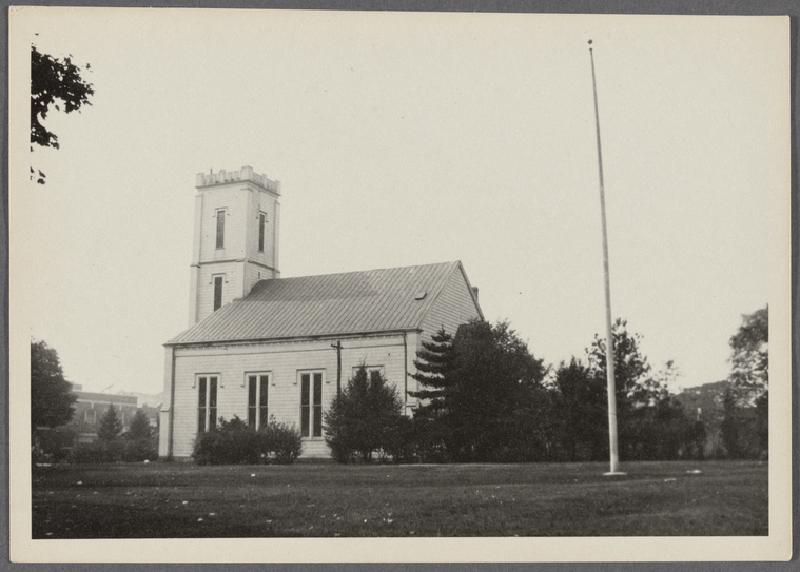
— Irma and Paul Milstein Division of United States History, Local History and Genealogy, The New York Public Library. “Christ’s First Presbyterian Church. North side Fulton Ave. near Railroad Depot. Established 1644. 6th edifice erected 1846, costing $7000. Remodelled 1906. Hempstead, Hempstead” The New York Public Library Digital Collections. 1922. https://digitalcollections.nypl.org/items/193de3c0-12d6-013c-d782-0242ac110004. View largest available size.
Reverend Locke had just moved to Hempstead from Brooklyn a few weeks prior to marrying the Mills, installed as pastor on 04 Dec 1850. He was remembered as “an able, discriminating, and impressive preacher, and gave evidence, wherever he was called to labor, of an honest and earnest devotion to the great work of the ministry.”

A Group of Former Pastors
…(7) N. C. Locke.
— 1895, Souvenir of the 250th Anniversary of Christ’s First Presbyterian Church: Hempstead, Long Island, N.Y., October 14, 15, 16, 1894, archive.org. View largest available size.
Edward and Mary Ann lived in West New Brighton throughout the 1850’s, when each of their children were born, and one, James, died. Based on tax assessment records from Corfu at the time, it seems that the Mills family moved from Staten Island to Corfu sometime between Sept 1862, when Edward’s store is not listed and May 1863, when Edward’s store is listed:
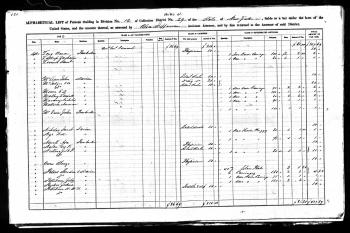
— 01 Sep 1862, District 29, Division 12, The National Archives and Records Administration; Washington, D.C.; Internal Revenue Assessment Lists for New York and New Jersey, 1862-1866; Series: M603; Roll: 196; Description: District 29; Annual Lists; 1864-1866; Record Group: 58, Records of the Internal Revenue Service, 1791 - 2006, ancestry.com. View largest available size.

— 01 May 1863, District 29, Division 12, The National Archives and Records Administration; Washington, D.C.; Internal Revenue Assessment Lists for New York and New Jersey, 1862-1866; Series: M603; Roll: 196; Description: District 29; Annual Lists; 1864-1866; Record Group: 58, Records of the Internal Revenue Service, 1791 - 2006, ancestry.com. View largest available size.
Note the following:
- The Mills’ move to Corfu is likely only a few months after the death of Reverend Locke.
- Despite living for many years in Hempstead where he died, Reverend Locke is buried in Batavia NY, exactly 13 miles (according to Google Maps) from Evergreen Hill Cemetery in Corfu NY, where Edward and Mary Ann are buried.
These facts strike me, although at the moment, I can’t claim these are more than coincidences, and perhaps even that reaches. Still, this seems worthy of further exploration, beginning with understanding why Reverend Locke is buried in Batavia, a place to which he does not appear to have any previous relationship.
Furthermore, the Reverend’s only surviving daughter at the time, Fanny Spencer Locke, 2nd (1860 to 16 Jul 1862) predeceased him by merely a week, and his father, Dr. John Locke (1784 to 01 Aug 1862) died two weeks after him. (Fanny was the older sister of Fanny Smith Locke (1854 to 06 Jun 1855).
First, an examination of Reverend Locke’s life, and family, beginning with his parents:

584 Dr. JOHN LOCKE, [1499] m. HANNAH GORDON CLARK, Jan. 14, 1810, who was b. in Leominster, May 18, 1786, dau. of Nathaniel and Mercy (Norcross) Clark, and gr. dau. of John and Hannah (Cutting) Clark, of Newton. Nathaniel, her father, first settled in Leominster, and 1791 moved to Rockingham, Vt. there kept a large tavern, and d. Ap. 8, 1833. Her mother was dau. of Uriah and Mercy (Watts) Norcross, of Boston. Dr. Locke received his medical education at the Medical College, Hanover, N.H. Commenced practice in Aug. 1809; resided four years in Langdon, N.H. seven in Salem, N.Y. and some time in Canada. Then removed to Rockingham, Vt. and became an agriculturist. He and his wf. now, 1852, reside with their son, Nathaniel, at Hempstead, Long Island, N. Y.
VII. Chil.
3886 Adeline Whiting, b. Oct. 8, 1810, at Rockingham.
3887 Helen Maria, b. July 8, 1812, at Langdon, N.H.; m. John Billings, July 22, 1846, from Oxfordshire, England. He is a miller at Bellows Falls, Vt. and had — 3888 Helen, b. Dec. 1849.
3889 Hannah Clark, b. Ap. 19, 1814, at Langdon; d. June 14, 1814.
3890 Nathaniel Clark, b. June 1, 1815. 1004
3891 Harriet Augusta, b. Oct. 23, 1817, at Salem, N. Y.; m. Joshua Hobart
— 1853, John Goodwin Locke, Book of the Lockes: A Genealogical and Historical Record of the Descendants of William Locke, of Woburn., James Munroe and Company, Boston MA, p204-205. View largest available size.
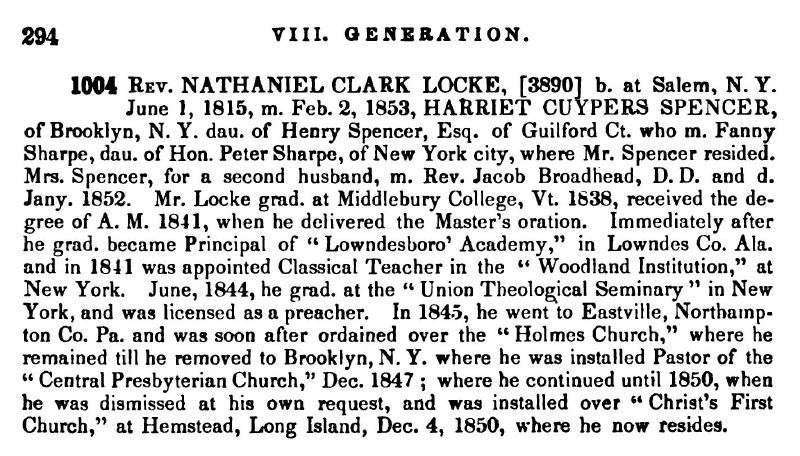
294 VIII. GENERATION.
1004 Rev. NATHANIEL CLARK LOCKE, [3890] b. at Salem, N. Y. June 1, 1815, m. Feb. 2, 1853, HARRIET CUYPERS SPENCER, of Brooklyn, N. Y. dau. of Henry Spencer, Esq. of Guilford Ct. who m. Fanny Sharpe, dau. of Hon. Peter Sharpe, of New York city, where Mr. Spencer resided. Mrs. Spencer, for a second husband, m. Rev. Jacob Broadhead, D.D. and d. Jany. 1852. Mr. Locke grad. at Middlebury College, Vt. 1838, received the degree of A. M. 1841, when he delivered the Master’s oration. Immediately after he grad. became Principal of “Lowndesboro’ Academy,” in Lowndes Co. Ala. and in 1841 was appointed Classical Teacher in the “Woodland Institution,” at New York. June, 1844, he grad. at the “Union Theological Seminary” in New York, and was licensed as a preacher. In 1845, he went to Eastville, Northampton Co. Pa. and was soon after ordained over the “Holmes Church,” where he remained till he removed to Brooklyn, N. Y. where he was installed Pastor of the “Central Presbyterian Church,” Dec. 1847 ; where he continued until 1850, when he was dismissed at his own request, and was installed over “Christ’s First Church,” at Hemstead [sic], Long Island, Dec. 4, 1850, where he now resides.
— 1853, John Goodwin Locke, Book of the Lockes: A Genealogical and Historical Record of the Descendants of William Locke, of Woburn., James Munroe and Company, Boston MA, p294. View largest available size.
In fact, Reverend Locke was the first pastor of Central Presbyterian Church, and it appears the Church was located at the northeast corner of the intersection of Willoughby and Pearl Street the entire time that Reverend Locke was minister there.
Central Presbyterian Church (Old School), Schermerhorn, near Nevins street. On the 19th of July, 1834, the Prince street Mission School was established under the direction of the Second Presbyterian church, then under the pastoral charge of the Rev. Ichabod S. Spencer. The success of that school, of which John Morris, the senior elder of the church, was the first, and C. C. Mudge the last superintendent, drew attention to the importance of a church in that section of the city, and on April 13th, 1847, twenty-five persons were set apart as it distinct church, under the title of the Central Presbyterian Church. Worship was conducted, at the school room in Prince street, until the purchase of the building in Willoughby street, corner of Pearl , formerly occupied by the Fifth Presbyterian church. The Rev, Nathaniel C. Locke was installed as the first pastor, and under his labors, the congregation grew and strengthened, and during a season of revival, a goodly number were added to its membership. Mr. Locke being dismissed in 1850, was succeeded by the Rev. Calvin Edson Rockwell, who was installed on the 13th of February, 1851. At length, after the lapse of two years, it became manifest that the church must secure a more attractive and permanent house in this part of the city. The erection of a new edifice, however, seemed at that time impracticable, until a sale had been first secured for their Willoughby street property, over which impended a heavy mortgage. On the evening of the 12th of January, 1853, the usual lecture was interrupted by a severe storm; but six or seven were present, who, with the pastor, held a prayer meeting, making the difficulties that were impeding the progress of the church, a special subject of prayer. On the succeeding week, an advantageous offer was made for the building, which was accepted at a meeting of the congregation, held on the evening of January 24th. A frame tabernacle was erected on the corner of State and Nevins streets, which was first occupied for public service on the 3d of April, 1853, and the congregation immediately proceeded with the erection of the new building, located on Schermerhorn, near Nevins street. The corner-stone was laid November 4, 1853, its basement was first opened for public worship on the 11th of June, 1854, and on the 10th of December, of the same year, the church was dedicated to the worship of God. It is a brick building, ninety-nine by sixty-two feet, having one hundred and forty four pews on the ground floor, and forty-two in the gallery. Its front is decorated with a portico of the Grecian Doric order, and its cost was estimated at about $30,000. In 1855, an extensive revival added largely to the number of the church. Dr. Rockwell resigned his charge in 1868, and was succeeded by the Rev. T. Dewitt Talmage, who was installed March 22d, 1869. Mr Talmage was born in Bound Brook, N. J., first studied law, then graduated at the University of the city of New York, and then pursued his studies for the ministry at the New Brunswick Theological Seminary. He came to Brooklyn from Philadelphia where he had been settled for seven years.
– Michael D. Cassidy, Presbyterian Churches, Panix.com.

The Rev. N. C. LOCKE, Pastor Elect of the Central Presbyterian Church in this city, will preach To-Morrow (SUNDAY) Morning and Afternoon at the usual hours. Nov. 13. 1t
— 13 Nov 1847, Brooklyn Evening Star, Brooklyn NY, p2, newspapers.com. View largest available size.
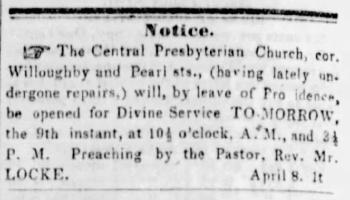
Notice.
The Central Presbyterian Church, cor, Willoughby and Pearl sts., (having lately undergone repairs.) will, by leave of Providence, be opened for Divine Service TOMORROW, the 9th instant, at 10 1/2 o’clock, AM., and 3 1/2 P. M. Preaching by the Pastor, Rev. Mr. LOCKE.
April 8. 1t
— 08 Apr 1848, Brooklyn Evening Star, Brooklyn NY, p2, newspapers.com. View largest available size.
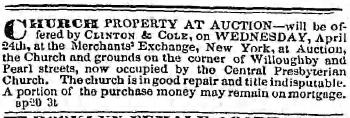
CHURCH PROPERTY AT AUCTION—will be offered by Clinton & Cole, on WEDNESDAY, April 24th, at the Merchants Exchange, New York, at Auction, the Church and grounds on the corner of Willoughby and Pearl streets, now occupied by the Central Presbyterian Church. The church is in good repair and title indisputable. A portion of the purchase money may remain on mortgage. ap20 3t
— 20 Apr 1850, Brooklyn Daily Eagle, Brooklyn NY, p3, newspapers.com. View largest available size.
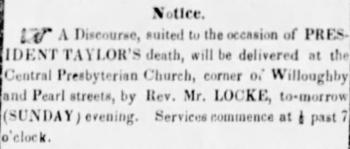
Notice.
A Discourse, suited to the occasion of PRESIDENT TAYLOR’S death, will be delivered at the Central Presbyterian Church, corner of Willoughby and Pearl streets, by Rev. Mr. LOCKE, to-morrow (SUNDAY) evening. Services commence at 1/2 past 7 o’clock.
— 13 Jul 1850, Brooklyn Evening Star, Brooklyn NY, p2, newspapers.com. View largest available size.

The Rev. N. C. Locke, late pastor of the Central Presbyterian Church, in Brooklyn, was installed over “Christ’s Church," Hempstead, L. I., on Wednesday, the 4th inst. The exercises were very interesting. Mr. Locke is the tenth pastor of this venerable old church, planted some 206 years ago, and now large and flourishing.
The Rev. and venerable Father Greene, was among those in the pulpit, and made some interesting remarks at the close. He was once a soldier in the army of Washington, doing good service for his country—since, for 60 years, a faithful soldier in the army of Christ, now the oldest Presbyterian minister in the United States, and resides in Hempstead.
— 11 Dec 1850, Williamsburgh Daily Gazette, Brooklyn NY, p2, newspapers.com. View largest available size.
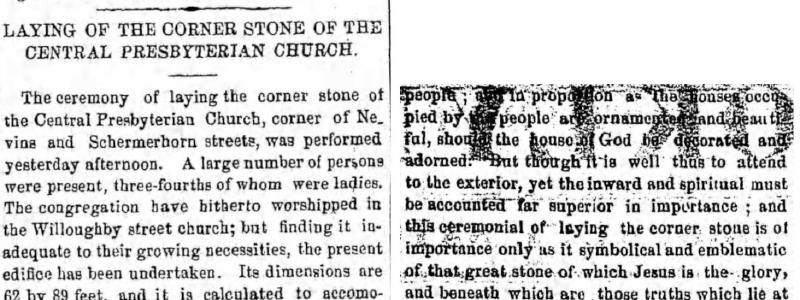
LAYING OF THE CORNER STONE OF THE CENTRAL PRESBYTERIAN CHURCH.
The ceremony of laying the corner stone of the Central Presbyterian Church, corner of Nevins and Schermerhorn streets, was performed yesterday afternoon. A large number of persons were present, three-fourths of whom were ladies. The congregation have hitherto worshipped in the Willoughby street church; but finding it inadequate to their growing necessities, the present edifice has been undertaken. Its dimensions are 62 by 89 feet, and it is calculated to accomodate [sic] about 1,500 persons. It fronts on Schermerhorn street. The front will be ornamented with a portico and heavy wooden cornice. The Rev. J. Edson Rockwel1 is pastor of the congregation. The building is being constructed under the superintendence of Mr. Grimsteep as architect, and Messrs. Mitchell & Campbell are the builders; and Robert White, carpenter. It will be of brick, and is expected to cost between $30,000 and $40,000.
The proceedings were opened by Rev. Mr. Wells of Williamsburgh, who offered the following prayer:
“Oh God, we rejoice that we have access to the throne of Grace by the Mediator between God and man, and we rejoice that we are permitted to meet on this occasion for the purpose that has now convened us. We implore thy presence and thy blessing, for unless the Lord build the temple, they labor in vain who build it. We thank thee for all the encouragement thou Last given us hitherto, and pray that thou wilt give us favor among men, and that we may be made strong by thee. Grant, Lord, this undertaking may prosper until the topmost stone shall be laid amid the rejoicings of thy people. Lord help those that are to speak to us, and at last may we be gathered from the various sanctuaries in which we worship God to the upper sanctuary, where thou dwellest for ever! We ask it for Christ’s sake, Amen.
Rev. Mr. Rockwell then came forward and said, “We are gathered together, my friends, to commence a work which you see has been already actually commenced; to lay the corner stone of a house of God, where we trust, in years to come, God will be worshipped, and where his people may meet together for the enjoyment of his precious ordinances, and where his truth will be proclaimed in purity, sincerity and truth. He then read a list of the articles to be deposited beneath the corner stone, and which were enclosed in a tin box, as follows:
The Book of Psalms of the Presbyterian Church of the United States, together with their form of Church government, and Catechism; a manuscript history of the Central Presbyterian Church; a list also in manuscript of the members of the Church, together with the heads of families that now compose the congregation; a list of the Presbyterian churches and Ministers of this city; the Twelfth Annual Report of the Brooklyn Bible Society, written by the Pastor, Mr. Rockwe1l; copies of the religious and secular newspapers of the day, &c. The Rev. Dr. Potts, of New York, then addressed those present as follows:
My dear Friends—The suggestions appropriate to such an occasion, are so numerous, and will so readily present themselves to your mind that it seems almost superfluous in me to add anything to what you would yourselves feel as the important and interesting features of such an occasion.
It is one of the most important of all the structures that can be erected in society—the corner stone of which we are about to lay. It is well for people to live in ceiled houses, and, as the growth of society progresses, additions to comfort and ornament in the residences of the people; and in proportion as the houses occupied by the people are ornamented and beautiful, should the house of God be decorated and adorned. But though it is well thus to attend to the exterior, yet the inward and spiritual must be accounted far superior in importance; and this ceremonial of laying the corner stone is of importance only as it symbolical and emblematic of that great stone of which Jesus is the glory, and beneath which are those truths which lie at the foundation of society here and in the world to come, and on which are erected superstructures that will endure for ever. We have the consolation of knowing that that structure is to be consecrated, not to pride and vanity, or ostentation, but to the worship and glory of God and the salvation of men. We are about to erect on this spot a church where, we trust, a pure sacrifice will always be offered. And you may feel sure that the glory of this house will excel the glory of many temples in which the worship of God is carried on unknowingly and ignorantly, without the simplicity of Christ and his Gospel. If we rely upon the mere appliances of outward ornament and the glory of architecture for the up-building of Christ’s temple, we shall feel and deserve to feel disgraced. But I have no fear, so long as a pure offering in the name of the great mediator is offered up within its walls.
The corner-stone was then laid with the usual ceremonies; a prayer being offered up by Rev. Mr. Greenleaf in which he invoked the Divine blessing on the undertaking, and prayed that the lives of the workmen might be preserved. An address was then delivered by Rev. Mr. VanDyke, Of the First Presbyterian Church of this city, in which he exhorted them to contribute towards the erection of the building. He said he did not know that he was exactly in his element, for he was there to beg. When he first entered the ministry he was ashamed to beg. He thought then that the only duty, the only business of a clergyman should be to preach. Experience, however, taught him better, and he could tell them now he was not ashamed to beg in any good cause; and what better cause could be beg for than for the head-spring of all blessings? He believed that the Gospel and Religion alone could save mankind; and however people who considered themselves enlightened might think they could do good by going after the quack advices of worldlings and politicians, he would assure them that it was the Gospel alone could save them. When the Israelites were called on to build a temple they were ordered to strip themselves of their rings and jewels to adorn it. He did not ask his auditory for their jewels, but just whatever loose change they could spare. He repeated the fable of Esop, where all the beasts of the field and birds of the air had collected around a spring in a dry season to drink, but could get no water on account of the depth of the spring. The fox told each one present to throw in a small stone which would cause the water to ascend so that they could easily reach it. He exhorted his hearers to throw in a stone each in the shape of a dollar or five dollar piece, and he hoped some of them would throw in a pocket full of rocks.
A collection was then taken up, and the assembly dispersed.
— 05 Nov 1853, Brooklyn Daily Eagle, Brooklyn NY, p2, newspapers.com. View largest available size.

BUSINESS NOTICES.
Going! Going!! Gone!!!—The friends of Mr. Joseph Hegeman, the well known Brooklyn Auctioneer, will learn, we think, with considerable pleasure, that from the success which has followed his earnest endeavors to give satisfaction to his patrons, he has found his Sales Room, at 191 Washington street, altogether inadequate for his business purposes, and has therefore removed to Willoughby, corner of Pearl st., to the capacious building, occupied for a long time by the members of the Central Presbyterian Church. He has, at a great cost, converted it into one of the finest sales rooms to be found either in New York or Brooklyn, where his friends will doubtless rally round him as heretofore. As a business man, Mr. H. has few superiors, as a prompt man in his settlements with his various customers, none. To give the public some idea of the capacity of the new room, for containing goods, we subjoin some particulars of the alterations. The pews have, of necessity, all been removed, and a broad and capacious gallery has been erected for the display of fancy goods. There is a lower apartment appropriated to business purposes. The steeple has been removed and a flagstaff erected in its place. On the days of sale the stars and stripes will be hoisted, to give notice to the public that the renowned Auctioneer will deliver on that day one of a business lecture. This capacious building presents altogether a very handsome appearance. The first sale, consisting of a large stock of furs, takes place on Thursday next, this will be a rare opportunity for the ladies, and will, doubtless, attract a large audience. We wish the new encumbent of the old Central Presbyterian Church, a successful career. We perceive that Mr. H. has well placarded Brooklyn with the announcement of his first sale, but were somewhat surprised to see a New York printer’s name attached to it.
— 16 Nov 1853, Brooklyn Daily Eagle, Brooklyn NY, p2, newspapers.com. View largest available size.
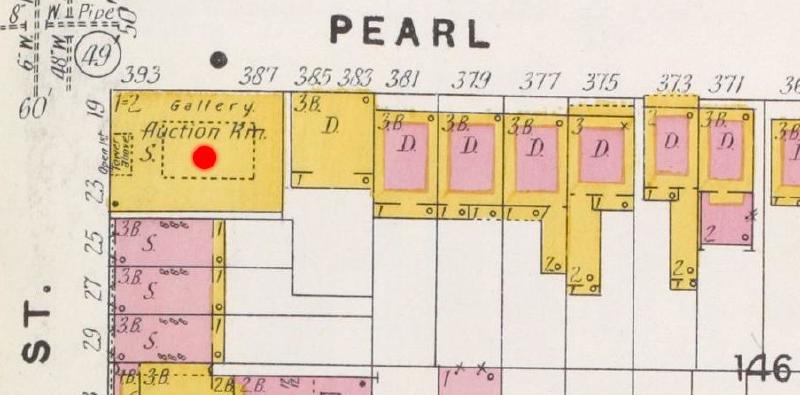
— Lionel Pincus and Princess Firyal Map Division, The New York Public Library. “Brooklyn V. 2, Plate No. 28 [Map bounded by Willoughby St., Pearl St., Adams St., Johnson St., Duffield St.]” The New York Public Library Digital Collections. 1884 - 1936. https://digitalcollections.nypl.org/items/2655e200-c5fd-012f-81c3-58d385a7bc34 . Cropped and highlighted in red. View largest available size.
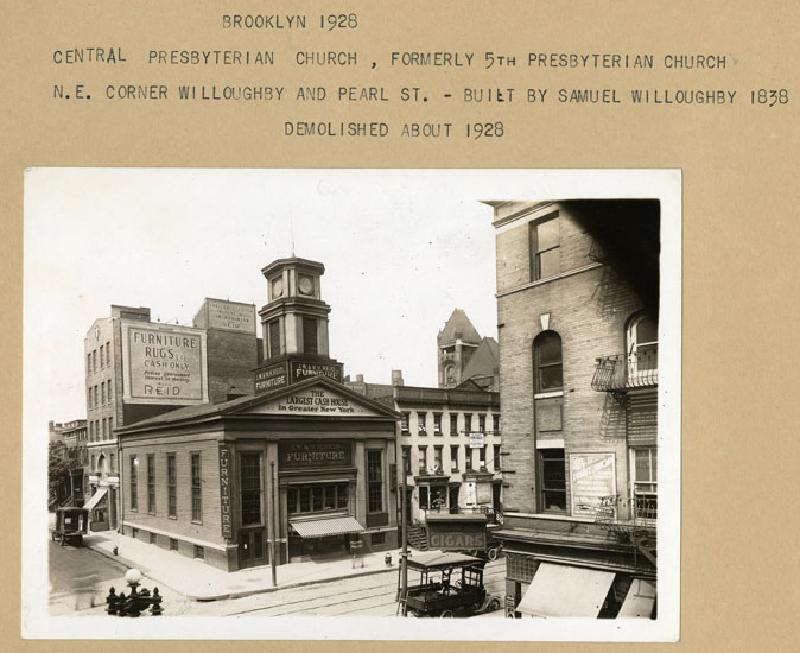
Brooklyn 1928
Central Presbyterian Church, formerly 5th Presbyterian Church
N.E. corner of Willoughby Street and Pearl St. – Built by Samuel Willoughby 1838
Demolished about 1928
— 1928, Eugene L. Armbtruster, , New-York Historical Society, Photographs of New York City and Beyond, ID: nyhs_PR081_b-08_034-01.jpg, Dcmny.org. View largest available size.
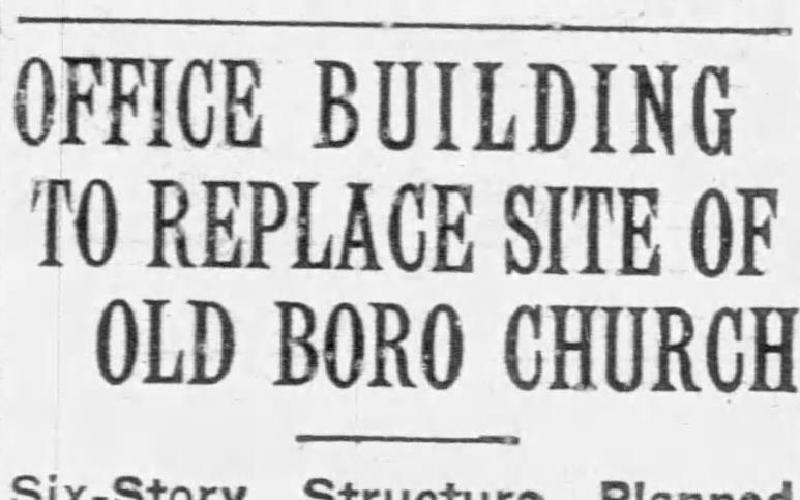
OFFICE BUILDING TO REPLACE SITE OF OLD BORO CHURCH
Six-Story Structure Planned for Willoughby St. Corner Leased to Building Firm.
The steady advancement of the Boro Hall neighborhood of Willoughby st., as a prominent office center, indicated during the past year in the replacement of old landmarks with large modern business buildings and offices, is further emphasized in plans announced for an office structure for the site of the old church building at the northeast corner of Pearl and Willoughby sts.
The improvement will result from a lease taken by the Pearl-Willoughby Corporation of the site from J. W. and W. H. Reid, Inc., for a long term at an aggregate rental of $500,000. The building, which will be six stories high, will cost close to $800,000. William Raymond Burling was the real estate broker for the landlords and Pierce W. Grace and Wollenberg & Son, for the tenants. Joseph Grodsky is is president of the Pearl-Willoughby Corporation.
This property is a site of historic importance in old Brooklyn, the corner building having been built in 1838 as a place of worship for the First Congregational Church. A bronze plate, which was in the cornerstone of the church building, is in the possession of the owner of the property, and carries such well-known names as Samuel Augustus Willoughby, commonly known as Lord Willoughby, and who erected the church; the Rev. Henry P. Tappan, first pastor of the church; Martin Van Buren, President of the United States; William L. Marcy, Governor of the State of New York; Jeremiah Johnson, Mayor of the City of Brooklyn, and tells the very interesting fact that the population of Brooklyn in 1834 was 27,000.
In 1845 the property was acquired from the church by Joseph Hegeman, who established the business which has been continuously transacted on the property from that time on. Some 35 years ago the property was acquired by William H. Reid, who has continued the business established over 80 years ago.
Mr. Grodsky is one of Brooklyn’s pioneer builders. His successful operations, having covered over a period of 25 years, include the construction of several large buildings in the Boro Hall section.
The existing building will be demolished in a short time and will be replaced with a building which will provide stores and offices of the most modern type and in keeping with the surroundings of the section.
Deal Indicates Trend of Business.
Mr. Burling, in speaking of this transaction, said, “This deal is a further indication of the business values which have come to Willoughby st. with the benefit of transit and its proximity to both the financial center at Boro Hall and the shopping center along Fulton st., whereby Willoughby st. combines throughout its length many of the valuable characteristics of both of these sections.
Neighboring Structures.
“With the development of the large office buildings of both the Brooklyn Edison Company across the street from this property, the Brooklyn Law School of 14 stories directly adjoining and the New York Telephone Company at Lawrence st., the development of Willoughby st. became assured.
“This particular property is peculiarly well located in that it is only a short block either from Boro Hall or from Fulton st., through Pearl st., and by its location on the northeast corner it is clearly visible from both of these streets.
“It is my opinion that with the building of the Jay st. subway these two short blocks on Willoughby st. are destined to become an integral part of the Boro Hall section.”
The attorneys in the transaction were Maurice J. Moore for the landlord and Louis J. Moss for the tenants.
— 05 Feb 1928, Brooklyn Daily Eagle, Brooklyn NY, p49, newspapers.com. View largest available size.

FURNITURE
AFTER 90 YEARS THE REID BUILDING IS COMING DOWN
A $300,000 STOCK IN OUR TWO BUILDINGS and WAREHOUSES MUST BE IMMEDIATELY SACRIFICED
The oldest Furniture House in Brooklyn — founded in 1841 — must soon close the doors of its present location at Willoughby and Pearl Streets. Built in 1838 as a Church and occupied since 1846 for business purposes, this structure is regarded as one of the oldest landmarks in the entire Borough.
As related in the news columns of this newspaper, the Reid organization, during the last week, relinquished this valuable property on a long term lease, the present buildings to be shortly demolished and one large, modern office building to be erected in their stead.
…
— 05 Feb 1928, Brooklyn Daily Times, Brooklyn NY, p76, newspapers.com. View largest available size.

Rev. N.C. Locke of Brooklyn has received a unanimous call to the Presbyterian Church in Hempstead, L. I.
— 23 Oct 1850, New York Daily Tribune, New York NY, p4, nyshistoricnewspapers.org. View largest available size.

The Rev. N.C. Locke, of Brooklyn, has received a unanimous call to the Presbyterian Church, of the village of Hempstead.
— 29 Oct 1850, Farmer And Advertiser, NY, pu, q34, fultonhistory.com. View largest available size.
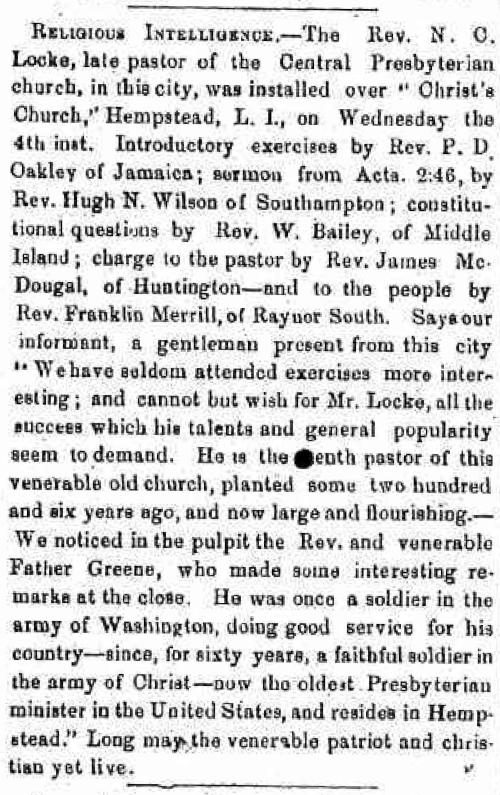
Religious Intelligence—The Rev. N.C. Locke, late pastor of the Central Presbyterian church, in this city, was installed over “Christ’s Church,” Hempstead, L.I., on Wednesday the 4th inst. Introductory exercises by Rev. P. D. Oakley of Jamaica; sermon from Acts. 2:46, by Rev. Hugh N. Wilson of Southampton; constitutional questions by Rev. W. Bailey, of Middle Island; charge to the pastor by Rev. James McDougal, of Huntington—and to the people by Rev. Franklin Merrill, of Raynor South. Says our informant, a gentleman present from this city “We have seldom attended exercises more interesting; and cannot but wish for Mr. Locke, all the success which his talents and general popularity seem to demand. He is the tenth pastor of this venerable old church, planted some two hundred and six years ago, and now large and flourishing. — We noticed in the pulpit the Rev. and venerable Father Greene, who made some interesting remarks at the close, He was once a soldier in the army of Washington, doing good service for his country—since, for sixty years, a faithful soldier in the army of Christ—now tho oldest. Presbyterian minister in the United States, and resides in Hempstead.” Long may the venerable patriot and christian yet live.
— 1850, Brooklyn Daily Eagle, pu, q11, fultonhistory.com. View largest available size.
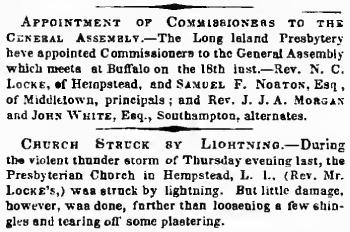
Appointment of Commissioners to the General Assembly.–The Long Island Presbytery have appointed Commissioners to the General Assembly which meets at Buffalo on the 18th inst.–Rev. N. C. Locke, of Hempstead, and Samuel F. Norton, Esq, of Middletown, principals; and Rev. J.J.A. Morgan and John White, Esq., Southampton, alternates.
Church Struck by Lightning.–During the violent thunderstorm of Thursday evening last, the Presbyterian Church in Hempstead, L.I. (Rev. Mr. Locke’s,) was struck by lightning. But little damage, however, was done, further than loosening a few shingles and tearing off some plastering.
— 03 May 1854, New York Daily Times, New York NY, p4, fultonhistory.com. View largest available size.

At Hempstead, on the 21st inst., by the Rev. N.C. Locke, James Seaman, Esq., to Miss Armina Duryea.
— 26 Feb 1856, Long Island Farmer and Advertiser, Jamaica NY, pu, fultonhistory.com. View largest available size.

LOCKE–At the residence of her son, the Rev. N C Locke in Hempstead, Long Island, on Thursday, Aug. 14, Mrs. Hannah Gordon Locke, wife of Dr. John Locke, aged 70 years.
Her remains were taken to Cypress Hills Cemetery.
— 20 Aug 1856, New York Daily Tribune, New York NY, p8, nyshistoricnewspapers.org. View largest available size.
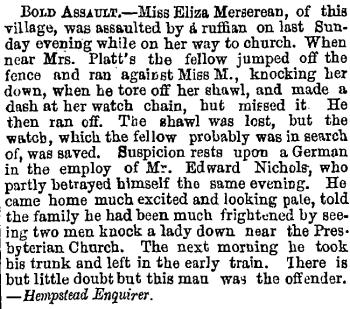
Bold Assault.—Miss Eliza Mersereau, of this village, was assaulted by a ruffian on last Sunday evening while on her way to church. When near Mrs. Platt’s the fellow jumped off the fence and ran against Miss M., knocking her down, when he tore off her shawl, and made a dash at her watch chain, but missed it. He then ran off. The shawl was lost, but the watch, which the fellow probably was in search of, was saved. Suspicion rests upon a German in the employ of Mr. Edward Nichols, who partly betrayed himself the same evening. He came home much excited and looking pale, told the family he had been much frightened by seeing two men knock a lady down near the Presbyterian Church. The next morning he took his trunk and left in the early train. There is but little doubt but this man was the offender. —Hempstead Enquirer.
— 18 Sep 1858, Brooklyn Daily Eagle, Brooklyn NY, p2, nyshistoricnewspapers.org. View largest available size.
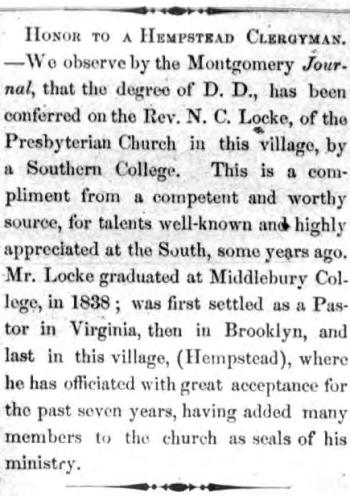
Honor to a Hempstead Clergyman. —We observe by the Montgomery Journal, that the degree of D. D., has been conferred on the Rev N. C. Locke, of the Presbyterian Church in this village, by a Southern College. This is a compliment from a competent and worthy source, for talents well-known and highly appreciated at the South, some years ago, Mr. Locke graduated at Middlebury College, in 1838 ; was first settled as a Pastor in Virginia, then in Brooklyn, and last in this village, (Hempstead), where he has officiated with great acceptance for the past seven years, having added many members to the church as seals of his ministry.
— 30 Sep 1858, Queens County Sentinel, Hempstead NY, pu, fultonhistory.com. View largest available size.
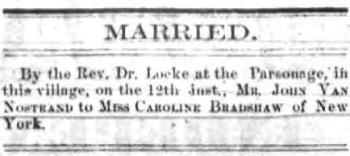
MARRIED.
By the Rev. Dr. Locke at the Parsonage, in this village, on the 12th inst., Mr. John Van Nostrand to Miss Caroline Bradshaw of New York.
— 18 Nov 1858, Queens County Sentinel, Hempstead NY, pu, fultonhistory.com. View largest available size.

MARRIED.
In this Village, by the Rev, Dr. Locke, at the Parsonage, on the 20th instant, Raynor R. Smith to Miss Ann Maria Storey, both of Freeport.
— 24 Nov 1859, Queens County Sentinel, Hempstead NY, pu, fultonhistory.com. View largest available size.
It appears that Reverend Locke’s illness began to curtail his activities in late 1859.
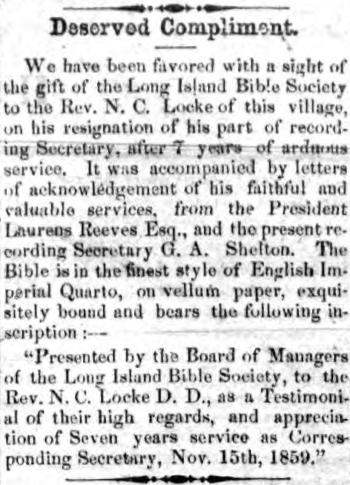
Deserved Compliment.
We have been favored with a sight of the gift of the Long Island Bible Society to the Rev. N. C, Locke of this village, on his resignation of his part of recording Secretary, after 7 years of arduous service. It was accompanied by letters of acknowledgement of his faithful and valuable services, from the President Laurens Reeves Esq., and the present recording Secretary G. A. Shelton. The Bible is in the finest style of English Imperial Quarto, on vellum paper, exquisitely bound and bears the following inscription:–
“Presented by the Board of Managers of the Long Island Bible Society, to the Rev. N. C. Locke D. D., as a Testimonial of their high regards, and appreciation of Seven years service as Corresponding Secretary, Nov. 15th, 1859.”
— 12 Jan 1860, Queens County Sentinel, Hempstead NY, pu, fultonhistory.com. View largest available size.
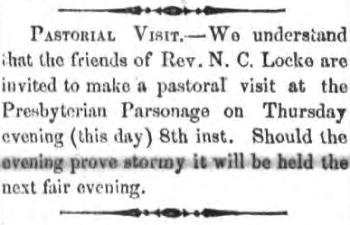
Pastorial Visit.–We understand that the friends of Rev. N. C. Locke are invited to make a pastoral visit at the Presbyterian Parsonage on Thursday evening (this day) 8th inst. Should the evening prove stormy it will be held the next fair evening.
— 16 Feb 1860, Queens County Sentinel, Hempstead NY, pu, fultonhistory.com. View largest available size.
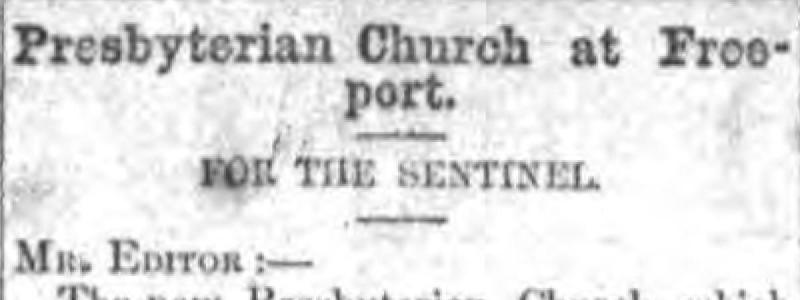
Presbyterian Church at Freeport.
FOR THE SENTINEL.
Mr. Editor:—
The new Presbyterian Church which has just been completed in Freeport was dedicated to the service of God, Wednesday last with appropriate services. — Rev. J. D. Wells of Brooklyn preached an excellent and timely sermon, from Gen. 28:17, “How dreadful is this place! this is none other but the house of God, and this is the gate of Heaven,” The exercises were engaged in with deep interest by a large and attentive congregation, Rev. P. D. Oakey of Jamaica, and Rev. N. C. Locke D. D. of Hempstead, were present, and took part in the services. Rev. Jas. Prior also was present, together with several distinguished strangers from other places.
After the sermon a statement was made of the pecuniary condition of the enterprise, slips of paper were distributed among the audience, and the friends were requested to put down their names with the suns they would give, when about $300 in pledges and money, were collected in a few minutes, One gentleman friend from Jamaica arose and said he would be one of twelve to pay off the whole balance. Are there not eleven others who will do likewise.— Another staunch friend of the little church put down his name for $100 without saying a word, though he resides in Brooklyn he is well-known and highly respected here by his oft-repeated noble deeds.
Our people themselves have done nobly, some of them beyond their means, others have given largely of their own competence, and, I presume, will add to what they have given, rather than see a burdensome debt resting on the church, which they have positively declared must be free from encumbrance. When I see one man putting down $500 in addition to $200 which had been previously subscribed by him, [ believe he means to have his church clear.
Our new building strikes those who have seen it for the first time as a little out of the usual and common style and yet ornate and beautiful. Some gentlemen from Brooklyn were delighted with it. It is an ornament to our place. I hope it will be more than that, a means of moral elevation and improvement— the audience room is very neat and convenient, and easy to speak in. It will seat about 350 by close stowing, Being warmed by a furnace from below, the eye is not offended by unsightly stove pipes, nor the ear with the rattling of stoves during service. And then we have a beautiful bell in the modest tower, which sounds forth its sweet and solemn tones over our quiet village, and out on the bay, calling us to the house of God and exciting in our hearts the reverent feeling of worship. This is the first church bell that has ever performed this holy Mission among this people and may its impressive calls be heard and obeyed.
M. D.
Freeport, April 7, 1860.
— 12 Apr 1860, Queens County Sentinel, Hempstead NY, pu, fultonhistory.com. View largest available size.
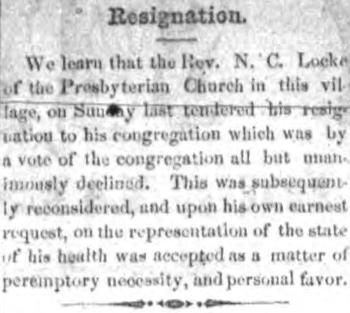
Resignation.
We learn that the Rev. N. C. Locke of the Presbyterian Church in this village, on Sunday last tendered his resignation to his congregation which was by a vote of the congregation all but unanimously declined. This was subsequently reconsidered, and upon his own earnest request, on the representation of the state of his health was accepted as a matter of peremptory necessity, and personal favor.
— 19 Apr 1860, Queens County Sentinel, Hempstead NY, pu, fultonhistory.com. View largest available size.
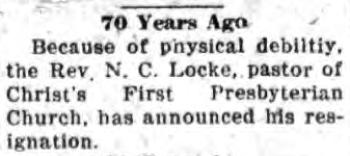
70 Years Ago
Because of physical debiltiy [sic], the Rev. N. C. Locke, pastor of Christ’s First Presbyterian Church, has announced his resignation.
— 10 Apr 1930, The Hempstead Sentinel, Hempstead NY, p13, nyshistoricnewspapers.org. View largest available size.

On Wednesday, the 2d February, at the Reformed Dutch Church, on the Heights, Brooklyn, N.Y., by the Rev. Dr. Bethune, the Rev. Nathaniel Clark Locke to Harriet Cooper Spencer.
— 16 Feb 1853, Middlebury Register, Middlebury VT, p3, newspapers.com. View largest available size.
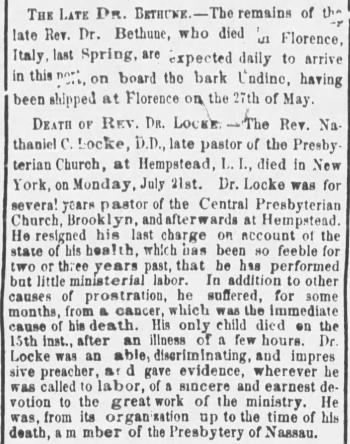
The Late Dr. Bethune.— The remains of the late Rev. Dr. Bethune, who died in Florence, Italy, last Spring, are expected daily to arrive in this port, on board the bark Undine, having been shipped at Florence on the 27th of May.
Death of Rev. Dr. Locke.— The Rev. Nathaniel C. Locke, D.D., late pastor of the Presbyterian Church, at Hempstead, L.I., died in New York, on Monday, July 21st. Dr. Locke was for several years pastor of the Central Presbyterian Church, Brooklyn, and afterwards at Hempstead. He resigned his last charge on account of the state of his health, which has been so feeble for two or three years past, that he has performed but little ministerial labor. In addition to other causes of prostration, he suffered for some months, from a cancer, which was the immediate cause of his death. His only child died on the 15th inst., after an illness of a few hours. Dr. Locke was an able, discriminating, and impressive preacher, and gave evidence, wherever he was called to labor, of a sincere and earnest devotion to the great work of the ministry. He was, from its organization up to the time of his death, a member of the Presbytery of Nassau.
— 26 Jul 1862, Times Union, Brooklyn NY, p2, newspapers.com. View largest available size.
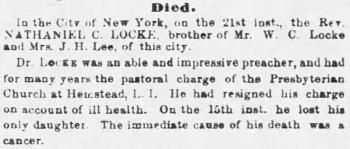
In the City of New York, on the 21st inst., the Rev. Nathaniel C. Locke, brother of Mr. W. C. Locke and Mrs. J. H. Lee, of this City.
Dr. Locke was an able and impressive preacher, and had for many years the pastoral charge of the Presbyterian Church at Hemstead, [sic] L. I. He had resigned his charge on account of ill health. On the 15th inst. he lost is only daughter. The immediate cause of his death was a cancer.
— 26 Jul 1862, The Buffalo Commercial, Buffalo NY, p2, newspapers.com. View largest available size.

Rev. Nathaniel C. Locke, D.D., late pastor or the Presbyterian Church at Hempstead, L.I., died in this city on Monday, July 21.
— 02 Aug 1862, Brooklyn Times, Brooklyn NY, p2, newspapers.com. View largest available size.

Rev. Nathaniel C. Locke, D D., late pastor of the Presbyterian Church at Hempstead, L.I., died in this city on Monday, July 21.
— 02 Aug 1862, Times Union, Brooklyn NY, p2, nyshistoricnewspapers.org. View largest available size.
Camera Lucida
The mystery of Reverend Nathaniel Clark Locke deepened when he seemed to reappear in an unexpected place. As I was researching the family of Charles M. and Elmira (Loper) Pine of Staten Island, I began corresponding with Martha Deed, who I later learned is a distant cousin of mine, and she educated me about Elmira’s family, the Lopers. When she offered a photograph of Elmira’s father Luther Loper, I was shocked to see a very familiar face, shown in the following high resolution scan of the original print artifact (600 DPI of 8x10 original) provided by the Huntington Historical Society, where Martha had donated the photograph:
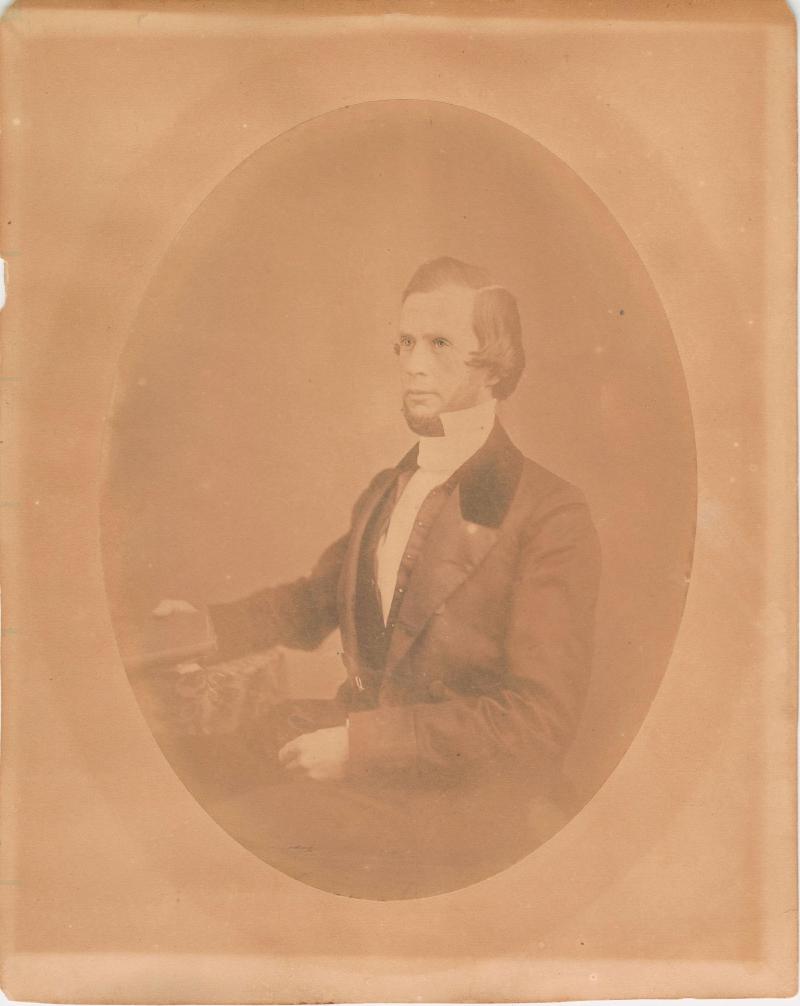
— Huntington Historical Society, Huntington NY. View largest available size.
For clarity, I enhanced the contrast, then grayscaled.

— Huntington Historical Society, Huntington NY. Cropped, contrast enhanced. View largest available size.
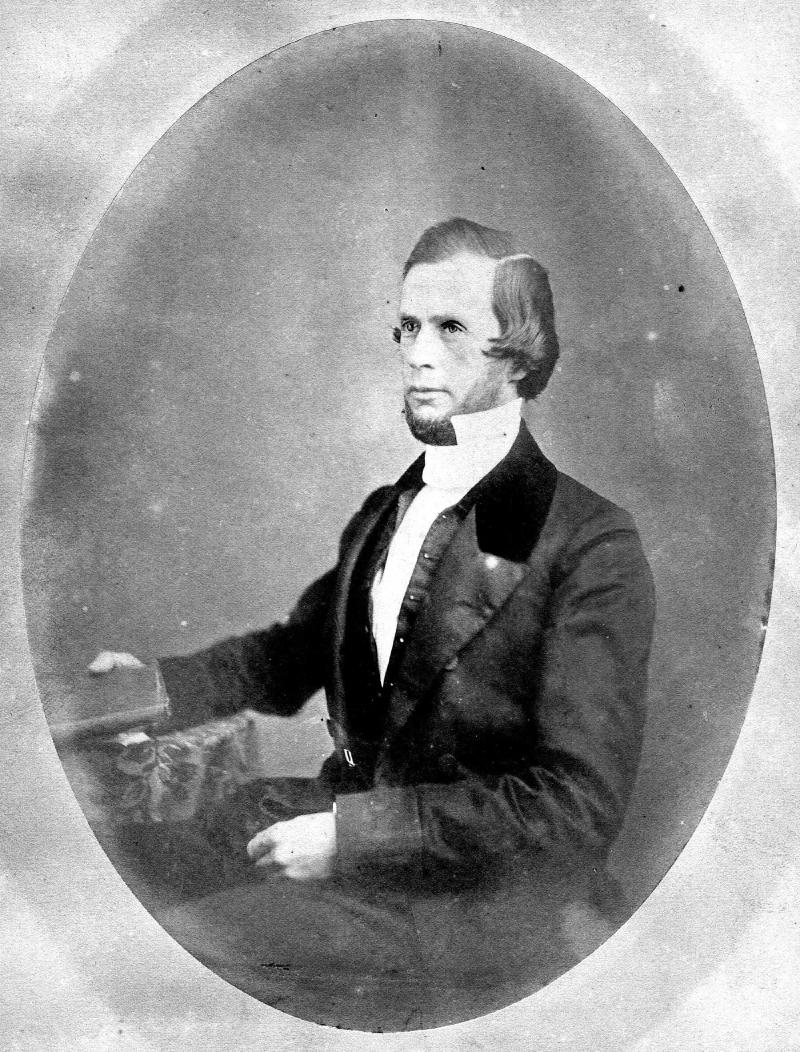
— Huntington Historical Society, Huntington NY. Cropped, contrast enhanced, grayscaled. View largest available size.
The Huntington Historical Society was also generous enough to provide a high resolution scan of the back of the photograph as well, which provides the identification.
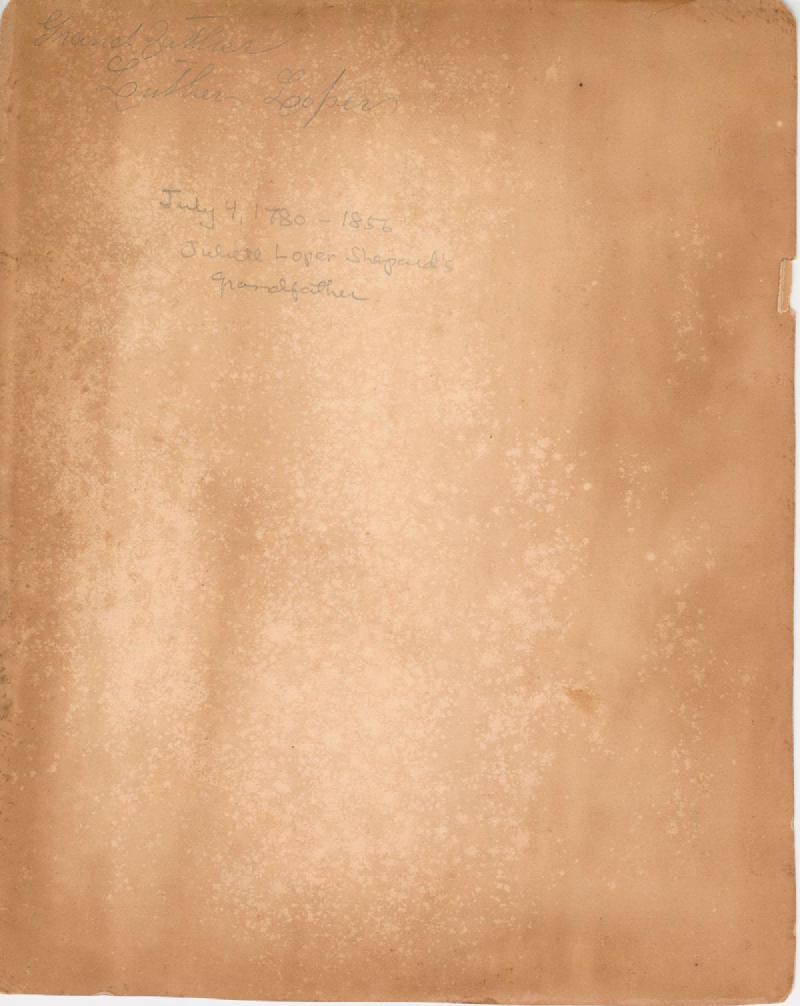
— Huntington Historical Society, Huntington NY. View largest available size.
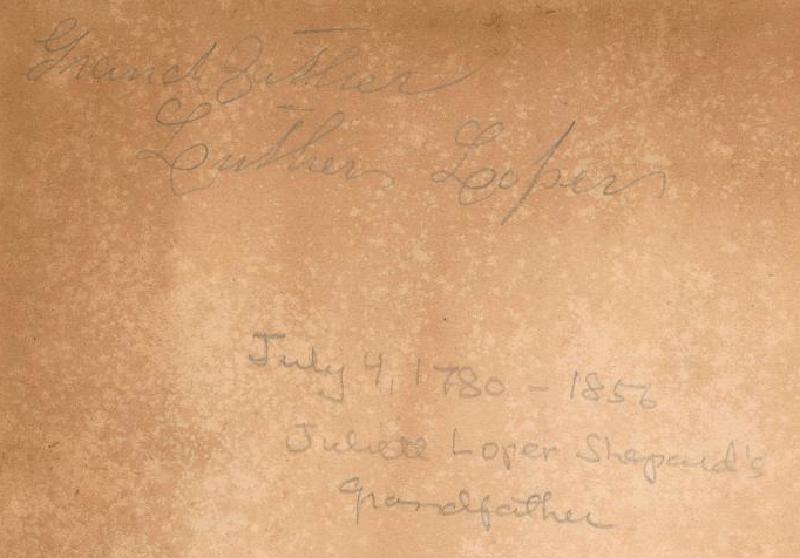
Grandfather
Luther Loper
July 4, 1780-1856
Juliett Loper Shepard’s grandfather
— Huntington Historical Society, Huntington NY. View largest available size.
The lower handwriting is obviously “modern”, and the attribution to Juliett Loper Shepard is confirmed by Martha Deed, who has transcribed many examples of Juliett’s handwritten letters. [TODO: can she provide an example well suited for comparison?]
But I recognize the man as Reverend Nathaniel Clark Locke, as he is shown in the “Souvenir” book image:

A Group of Former Pastors
…(7) N. C. Locke.
— 1895, Souvenir of the 250th Anniversary of Christ’s First Presbyterian Church: Hempstead, Long Island, N.Y., October 14, 15, 16, 1894, archive.org. View largest available size.

As the following records show, Luther Loper appears to have been a relatively affluent farmer, and was apparently wealthier than Reverend Locke, despite the prestige of the Reverend’s position. Luther’s real estate was valued at $5,000 in the 1850 census, and that same year, Reverend Locke is still living in Brooklyn when he is counted in the census on 13 Aug, with no real estate listed. Luther lived in Hempstead for many years before his death, and he was a member of Hempstead Presbyterian Church when Reverend Locke became its pastor, and Reverend Locke was still pastor when Luther died, presumably officiating his funeral.
| Year | Town | Occupation | Real Estate |
|---|---|---|---|
| 1850 | Hempstead | Farmer | $5,000 |
| 1840 | Hempstead | na | na |
| 1830 | Islip | na | na |
| 1820 | Islip | na | na |
– 1820 to 1850, Luther Loper, United States Federal Census, Ancestry.com.
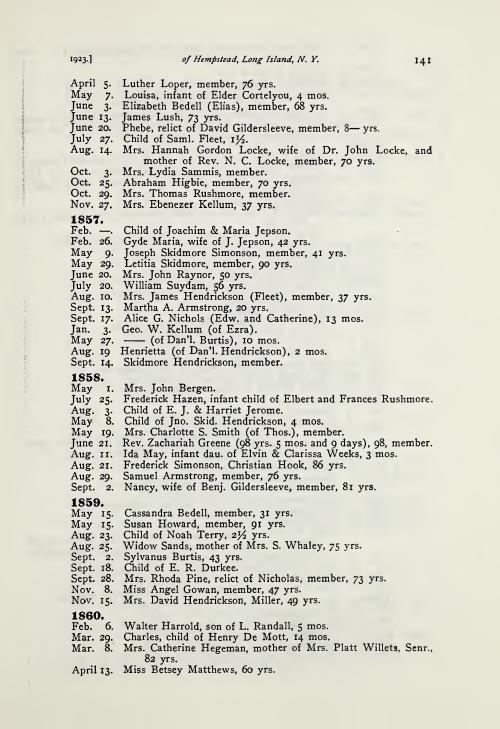
[1856]
…April 5. Luther Loper, member, 76 yrs.
…Aug. 14. Mrs. Hannah Gordon Locke, wife of Dr. John Locke, and Mother of Rev. N. C. Locke, member, 70 yrs.
…1858.
…June 21. Rev. Zachariah Greene (98 yrs, 5 mos. and 9 days), 98, member.
…1859.
…Sept. 28. Mrs. Rhoda Pine, relict of Nicholas, member, 73 yrs.
— 1923, History and Vital Records of Christ’s First Presbyterian Church of Hempstead, Long Island, New York, Contributed by John Dean Fish, The New York Genealogical and Biographical Record, Volume 54, p141, Archive.org. View largest available size.
For convenience, I will refer to the purported photograph of Luther Loper as the Grandfather photograph, and the purported image of Reverend Locke, the Souvenir image.
As I continue this exploration, I will make the following assumptions:
- The two images are of the same man, captured in two different exposures in the same sitting.
- At least one of the attributions is correct. In other words, I am not considering the possibility that both images are mis-identified.
I believe it is quite evident this is the same man, photographed on the same day. Among the many similarities, the clearest include:
- The hair is quite distinctive: side parted and slicked over, the sides are swept forward over the cheeks, and the hair is gathered around the base of his skull. There is also a “widow’s peak”.
- The facial hair is “Amish style”, a beard without a mustache, a style President Abraham Lincoln adopted after his 1860 election. Notice that each image shows the same uneven pattern of beard growth on the left side of each face.
- The shirt collar is turned up, and there is a rounded set of ruffles in the front. The jacket has a two-tone collar.
But which identification is correct? First, let’s recognize two facts working in our favor for identification:
- Luther Loper and Reverend Locke were not close in age, so if either photograph can be dated, the correct identification should be clearly evident.
- Despite their age difference, the two men died only a few years apart, greatly helping to constrain the date range of the photograph, assuming one identification is correct.
| Name | Birth | Death | Age at Death |
|---|---|---|---|
| Luther Loper | 1780-06-04 | 1856-04-05 | 75 |
| N.C. Locke | 1815-06-01 | 1862-07-21 | 47 |
I began by reflecting on the hair and beard style, which seems relatively modern, and various aspects of the style of clothing. Most notably, the upturned collar struck me as a style that might indicate a member of the clergy.
In the 1850s, that kind of collar was common for non-clerical men to wear. It doesn’t look like a reverend’s collar in particular, but I would consult texts on 19th-century men’s clothing to be sure.
— 19 Mar 2024, Michelle L. Smiley, Associate Curator of Photography, Prints & Photographs Division, Library of Congress, personal correspondence.
I have since confirmed that this type of collar was indeed a common fashion of the time. It can be seen for example, on an 1845 lithograph of photographer Mathew Brady. (Note that Mathew Brady lived on Staten Island, in the town of Southfield, Richmond County, during the time that Edward Mills’ family lived in the adjacent adjacent town of Castleton.)
In the Grandfather photo, we also see the gentleman holding a book. I speculated that this could be a Bible, a prop intended to symbolize the man’s profession:
It was also very common for photographic sitters to hold all types of books. Sometimes a Bible but in other instances any regular book or even a photographic album, which is easily mistaken for a book. So it’s hard to say with any certainty what is in his lap. I can’t make out the piece of hardware near his lap. Again, consulting a book or other expert on mid-19th-century men’s fashion may be useful here.
— 19 Mar 2024, Michelle L. Smiley, Associate Curator of Photography, Prints & Photographs Division, Library of Congress, personal correspondence.
Another intriguing aspect of the Grandfather photo is that his eyes appear to have been manually outlined.
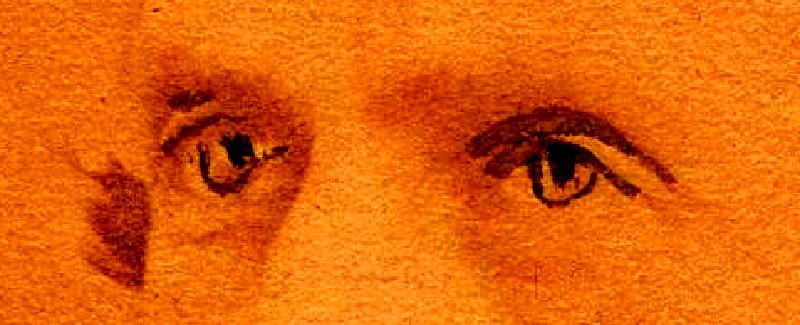
As for the outline on the eyes, that looks like someone drew on the photographic print after the fact to make the eyes more prominent. This could have been done many years later or at the time of its production, as was very common at the time. It would have been a way to supplement the fuzziness of a salt print with more defined edges or where more detail was wanted.
— 19 Mar 2024, Michelle L. Smiley, Associate Curator of Photography, Prints & Photographs Division, Library of Congress, personal correspondence.
Looking at the Souvenir photograph, the shirt collar and ruffles are more pronounced than in the other images, and if the original artifact is ever located, it would be interesting to examine it to see if these had been manually enhanced afterward in a similar way.
Turning to the medium of the Grandfather photograph itself, it is clearly a paper-based print, as abundantly evident from the damaged edge of the scanned print:
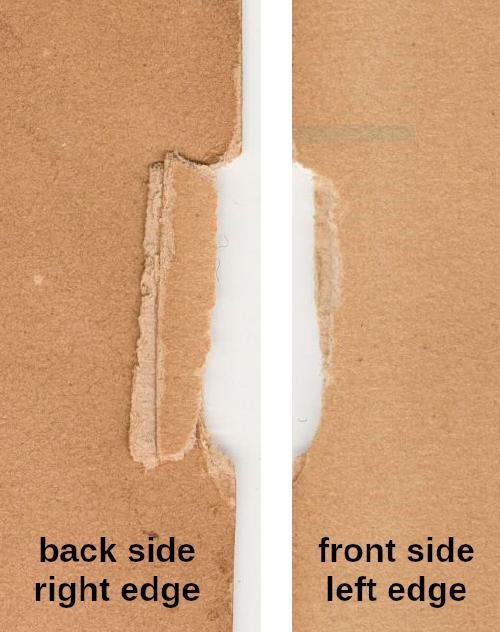
Prior to 1860 in America, the primary commercial paper-based print photographic processes were calotypes (also known as salted paper prints ), and later, albumen prints, both of which were produced from negatives, so that the photographs could be reproduced, as opposed to Daguerrotypes, for example, which were unique positives. (I believe it is plainly evident that Grandfather is not a cyanotype.) It appears that the popularity of calotypes in America was waning just as the popularity of albumin prints was rising and becoming widespread by the mid-1850’s.
Most Common Types of Photographic Paper, 1840-1905
1840-1855 Salted Papers
1855-1895 Albumen Papers
1895-1905 Gelatin and Collodion Printing-out Papers
Within the span 1840-1905 there are obviously periods of transition from one type of printing paper to another, and in these transition periods the date of origin of an image is not much help in identifying the specific print process. On the other hand, there are also spans of time where there can be little doubt as to the printing paper in use by the vast majority of photographers. One such time is of course the 10-year period between 1840 and 1850, before the invention of albumen paper. Except for very rare cases where the prints were made by development (using the calotype, or paper negative process) prints of this decade are plain salted paper prints.
The years 1850-1860 represent a transition period between salted papers and albumen papers. For the first few years of the decade plain salted papers predominated, while at mid-decade came a time of unprecedented variety, as albumen paper coexisted with a number of different kinds of matte salted papers. These matte salted papers were treated with a salting-sizing solution using an organic binder such as gelatin, whey or starch among other substances. It is not possible to differentiate at a glance between these various types of matte salted paper. As the year 1860 drew closer, albumen paper gradually replaced most of the varieties of salted papers, and ascended to an almost unchallenged dominance of photographic practice.
Thus the period 1860-1885 is a time of reasonable certainty with regard to process identity, and there is a great likelihood that any given silver photographic print of that period was made on albumen paper.
— 1980, James M. Reilly, The Albumen & Salted Paper Book: The History and Practice of Photographic Printing, 1840-1895, Rochester NY, p123.
One aspect that struck me when I originally examined the Souvenir photograph was the fuzzy, indistinct nature of it, almost more like a realistic painting than a photograph. Lower clarity of detail is a key defining characteristic of caloptypes, whereas albumen prints had greater clarity of detail and contrast.
The calotype, which is also known as a salted paper print or salt print, is distinct from other forms of paper photography in that the photographic material (the darkened areas of the picture that make up the photograph) is actually embedded into the paper itself. This gives this type of print a “fuzzy” quality that is distinct from something like an albumen photograph, where the photographic material is suspended in a layer of albumen (egg whites) on top of the paper, which gives that process a sharper image.
— 13 Mar 2024, Michelle L. Smiley, Associate Curator of Photography, Prints & Photographs Division, Library of Congress, personal correspondence.
William Henry Fox Talbot patented a photographic process in 1841 that led to a stable negative image. The process involves exposing a sheet of sensitized paper in the camera then developing, fixing, and washing it. The stable negative image could be contact printed.
Though calotypes are soft and hazy, with visible paper fibers, the invention revolutionized image-making by making it possible to produce multiple prints from one negative image. It was also used as a means of making copies of drawings and documents. The process remained in use through the 1850s, when it was replaced by the albumen silver print.
— Calotype, moma.org. Emphasis added.
Looking at the closeup of a portion of Grandfather photograph, the paper texture is clearly visible:
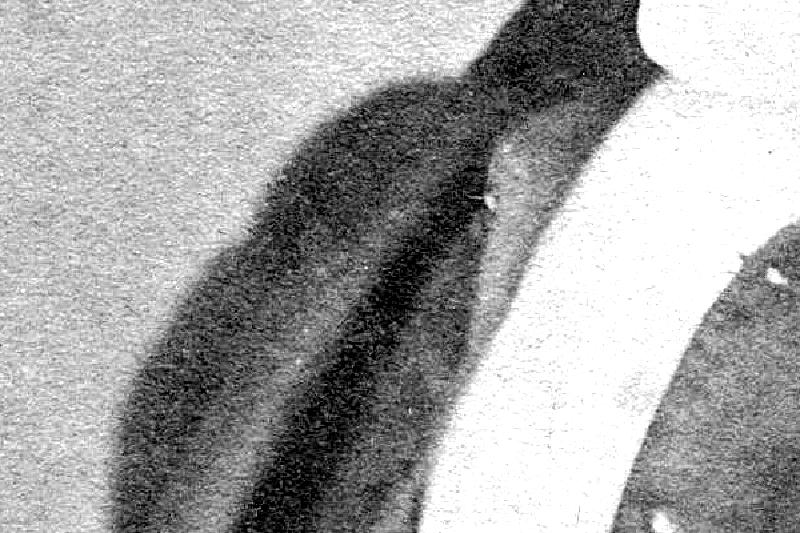
For an exhaustive description of the calotype process from the time period in question, see 1856, Thomas Sutton, The Calotype Process: A Handbook to Photography on Paper, e2, Archive.org.
The albumen printing process as it was actually used during the 19th century was the invention of Louis Desire Blanquart-Evrard, a pioneer French photographer who made many important contributions to photography. He was both a talented photographer and a technical innovator, and his writings on photography were very influential. Without doubt his most useful and far-reaching discovery was the albumen print, the photographic medium upon which the last half of the 19th century was recorded.
The discovery of albumen paper came in the late 1840’s as Blanquart-Evrard searched for improvements in Talbot’s calotype process. Blanquart-Evrard tried and was somewhat successful in using albumen as a carrier for the light-sensitive salts on paper negatives, and he went further and adapted it to the usual method of making positives on plain salted paper. It worked splendidly as a positive material, and provided a deeper, bolder image than could be obtained on the matte salted papers of the day.
Blanquart-Evrard communicated his discovery to the world in a brief account of his various photographic researches which he presented to the French Academy of Sciences on May 27, 1850. Photographers were quick to tr out the new method for positive prints, and it became an almost instant success. By 1855 most serious photographers had at least tried–if not adopted–albumen paper.
— 1980, James M. Reilly, The Albumen & Salted Paper Book: The History and Practice of Photographic Printing, 1840-1895, Rochester NY, p28.
Many photographic materials have similar surface qualities and the appearance of any surface may be altered by smoothing or the application of other substances. Nevertheless the basic fact remains that salted paper prints are rough or matte-surfaced, while albumen prints are smooth and display a greater or lesser degree of surface gloss. Salted paper prints were made on both smooth and porous rawstocks of various weights, but albumen prints (especially after 1860) were generally made on a very smooth, lightweight stock. Albumen prints of the period 1850-1870 are usually less glossy than those of the period 1870-1890, because of two factors: the use of burnishing and rolling machines to smooth the prints after mounting, and the increased use after 1870 of double-coated paper.
— 1980, James M. Reilly, The Albumen & Salted Paper Book: The History and Practice of Photographic Printing, 1840-1895, Rochester NY, p122.
I have made some attempt to identify calotype photographers in New York City, Brooklyn, and Hempstead, without much success. Beginning with Doggett’s New York City Directory for 1850-1851 (Archive.org), I cannot find any variation of the word “calotype”, and I can only find one variation of “photo*”, on p532, Madam B. Wehnert’s “phototypic studio”, otherwise, all references to photographers seems to be some variation of “daguerreotype”, including “daguerreotypes”, “daguerreotypist”, “daguerrist”, “daguerrot”, “daguerrian ”, “daguerreanist”, and “daguerrian artist” as well as entries such as “daguerrian gallery” and “daguerreotype goods”. Most notable among the dagerrians was Mathew Brady, whose establishment, Brady’s National Gallery of Daguerreotypes at 205 and 207 Broadway, on the corner of Fulton Street, a block from J.W. Orr’s firm (explored below), was already well established. (Ibid., p108.) To see an example of a daguerreotype by Brady see the portrait of William Sidney Mount in that section of this work. In the 01 May 1856 publication of Trow’s New York City Directory (Archive.org.) variations of both “photographer” and “daguerreotype” are found, but not “calotype”.
But there are local advertisements for calotype specific chemicals and other indications of the calotype process in use during this time period.
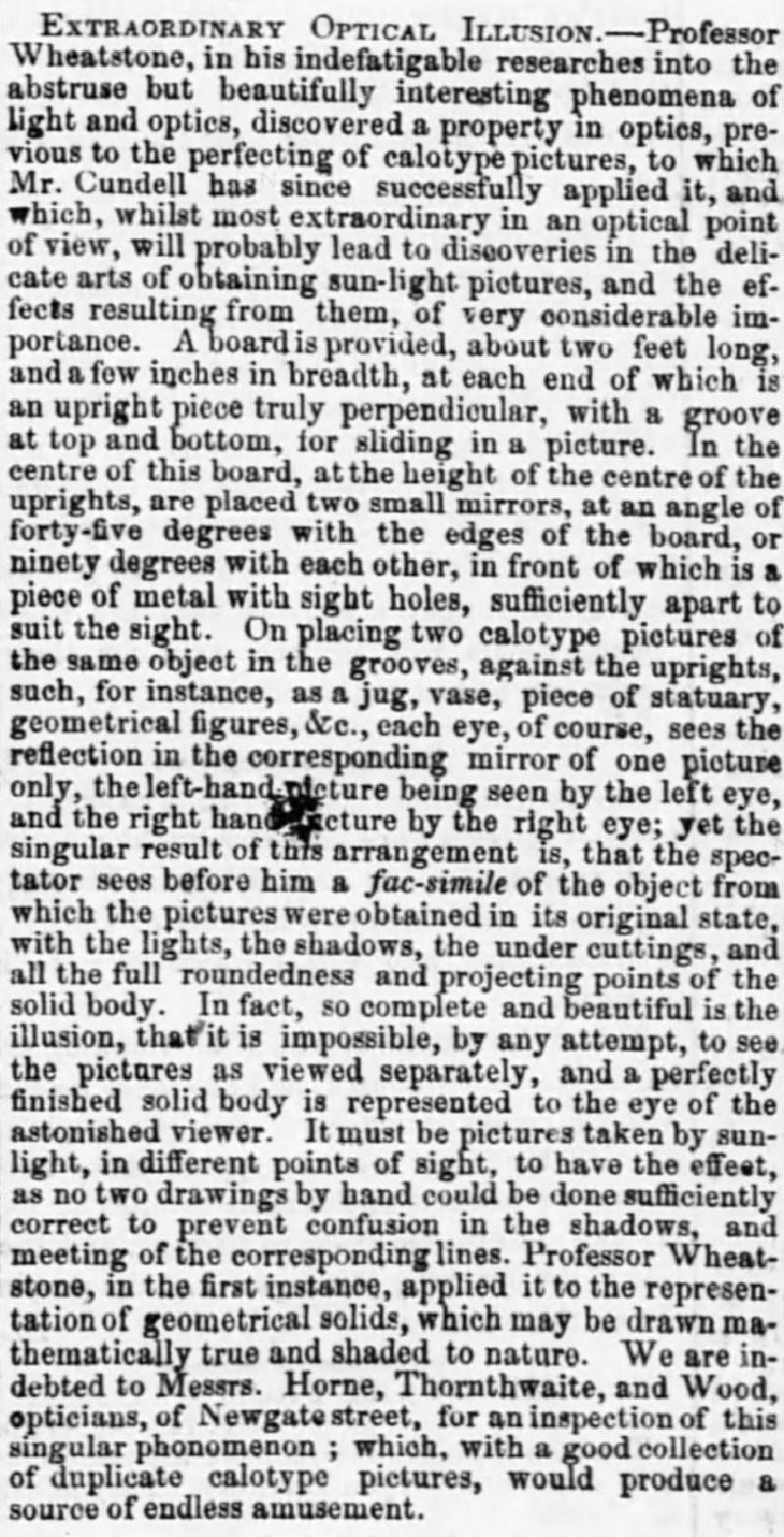
Extraordinary Optical Illusion.—Professor Wheatstone, in his indefatigable researches into the abstruse but beautifully interesting phenomena of light and optics, discovered a property in optics, previous to the perfecting of calotype pictures, to which Mr. Cundell has since successfully applied it, and which, whilst most extraordinary in an optical point of view, will probably lead to discoveries in the delicate arts of obtaining sun-light pictures, and the effects resulting from them, of very considerable importance. A board is provided, about two feet long, and a few inches in breadth, at each end of which is an upright piece truly perpendicular, with a groove at top and bottom, for sliding in a picture. In the centre of this board, at the height of the centre of the uprights, are placed two small mirrors, at an angle of forty-five degrees with the edges of the board, or ninety degrees with each other, in front of which is a piece of metal with sight holes, sufficiently apart to suit the sight. On placing two calotype pictures of the same object in the grooves, against the uprights, such, for instance, as a jug, vase, piece of statuary, geometrical figures, &c., each eye, of course, sees the reflection in the corresponding mirror of one picture only, the left-hand picture being seen by the left eye, and the right hand picture by the right eye; yet the singular result of this arrangement is, that the spectator sees before him a fac-simile of the object from which the pictures were obtained in its original state, with the lights, the shadows, the under cuttings, and all the full roundedness and projecting points of the solid body. In fact, so complete and beautiful is the illusion, that it is impossible, by any attempt, to see the pictures as viewed separately, and a perfectly finished solid body is represented to the eye of the astonished viewer. It must be pictures taken by sunlight, in different points of sight, to have the effect, as no two drawings by hand could be done sufficiently correct to prevent confusion in the shadows, and meeting of the corresponding lines. Professor Wheatstone, in the first instance, applied it to the representation of geometrical solids, which may be drawn mathematically true and shaded to nature. We are indebted to Messrs. Horne, Thornthwaite, and Wood, opticians, of Newgate street, for an inspection of this singular phonomenon; [sic] which, with a good collection of duplicate calotype pictures, would produce a source of endless amusement.
— 04 Aug 1848, The Evening Post, New York NY, p1, Newspapers.com. View largest available size.

Meade, Brothers, Emporium of Art.— Daguerreotypes, Cameos, Lithographs, Paintings on Ivory and Canvas, Calotypes &c., taken daily, by ourselves and the first artists in the country. Awarded four medals by the American Institute, American Galleries, 233 Broadway, three doors above the Astor House.
— 11 Nov 1851, New York Daily Herald, New York NY, p4, Newspapers.com. View largest available size.
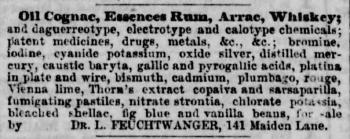
Oil Cognac, Essences Rum, Arrac, Whiskey; and daguerreotype, electrotype and calotype chemicals; patent medicines, drugs, metals, &c., &c.; bromine, iodine, cyanide potassium, oxide silver, distilled mercury, caustic baryta, gallic and pyrogallic acids, platina in plate and wire, bismuth, cadmium, plumbago, rouge, Vienna lime, Thorm’s extract copaiva and sarsaparilla, fumigating pastiles, nitrate strontia, chlorate potassia, bleached shellac, fig blue and vanilla beans, for sale by Dr. L. FEUCHTWANGER, 141 Maiden Lane.
— 30 Nov 1854, New York Daily Herald, New York NY, p5, Newspapers.com. View largest available size.
A simple search of New York newspapers (on nyshistoricnewspapers.org) between 1840 and 1860 for “calotype” finds mentions of the process beginning with a Watertown advertisement on 17 Oct 1849, and, starting 19 Jul 1850 and ending 28 Nov 1851, advertisements run in Elmira which comprise the bulk of mentions. In each of these cases, they are advertising supplies and equipment related to the process. A similar advertisement can be found in Rochester on 22 Jan 1852, and the latest reference to its use can be found in Penn-Yan on 02 Apr 1856, where it appears to be part of a general discussion of photographic processes of the time.
I’m not comfortable making a definitive ID from the digital snapshot, but it looks like it could be a candidate for a salted paper print. One of my photography colleagues recommended looking at the print under raking light (you can use your phone flashlight holding it over the print at 90 to 45 degrees). If you see a shiny surface, then you have an albumen print. If not, it’s most likely salted paper/calotype.
— 14 Mar 2024, Michelle L. Smiley, Associate Curator of Photography, Prints & Photographs Division, Library of Congress, personal correspondence.
Michelle Smiley from the Library of Congress referred me to GraphicAtlas.org which has detailed information on identifying calotypes. Compare this description of fading due to silver oxidation against the original scan of the grandfather photograph, which is noticeably more faded at the edges:
Oxidation appears as fading and change in image tone toward yellow-brown; this occurs first in highlights where there is less silver; in books and albums, fading tends to occur from the edges into the center of the print. Sulfiding appears as an overall warm, yellow-brown color.
— Salted Paper, graphicatlas.org. Emphasis added.

— Huntington Historical Society, Huntington NY. View largest available size.
Next, compare the following description of image tones and colors against the version of the grandfather photograph in which only the contrast was digitally adjusted:
Warm image tones ranging from reddish brown to purple or yellowish are an identifying feature of salted paper prints as well as other printed out prints. Small, photolytic silver image particles are formed by the action of ultraviolet light on the light sensitive silver chloride crystals. Photolytic silver yields a warm, reddish, color. Therefore early, un-toned prints are a red or red-brown. Sulfur and gold toning were regularly used to give prints a brown or purple-brown hue. The final print color is dependent on paper and sizing type, print exposure, toner formula, and length of time in the toning bath. Common deterioration such as foxing, fading, yellowing, and loss of highlight detail will alter the image tone.
— Salted Paper, graphicatlas.org. Emphasis added.
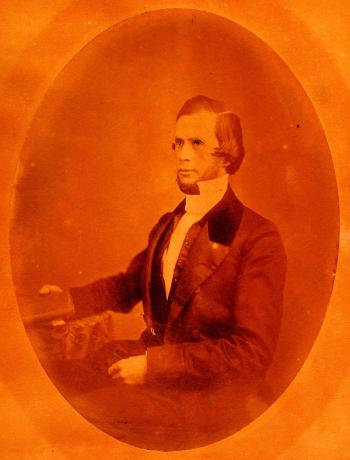
— Huntington Historical Society, Huntington NY. Cropped, contrast enhanced. View largest available size.
(TODO: Is it valid to compare a physical description against a digitally enhanced scanned photograph?)
The Souvenir photograph, used for the publication when the photograph was approximately four decades old, appears to show spots when magnified, most pronounced against the dark collar I might add, although these apparent defects could have other explanations unrelated to the condition of the underlying photograph used. The much older Grandfather photograph doesn’t show the same defects, and of course, the prints could have been produced at different times with varying qualities of papers and chemical solutions, and obviously, they could have been stored under very different conditions. The Grandfather photograph appears to show variations in paper thickness and resulting absorption of the coating, perhaps most apparent around his face and extending vertically in the contrast enhanced grayscaled version presented above.
Albumen and salted paper prints in original condition are usually warm brown, purplish-brown, purple, or purplish-black. They are seldom black, but occasionally they will approach neutral black yet still contain some trace of purple in middletone areas. They are never green, but severely faded and yellowed albumen prints sometimes possess a faint greenish tinge. Approximately 85% of albumen prints show some readily noticeable yellowing and the characteristic surface texture of albumens are two of the most readily apparent and reliable indicators that a given print is an albumen print. Albumen prints are certainly not the only types of prints that may exhibit highlight yellowing, however, so one must also watch for contraindications that may be present.
— 1980, James M. Reilly, The Albumen & Salted Paper Book: The History and Practice of Photographic Printing, 1840-1895, Rochester NY, p122.
For comparison, several examples of albumen prints can be seen in the family portraits of The Mills of Buffalo.
I believe the Grandfather photograph is a calotype/salted paper print, and by extension, so was the artifact used for the Souvenir image. This constrains the timeframe for the date of the photograph to the early 1840’s on the extreme low end to Reverend Locke’s death on the high end, as that also encompasses Luther Loper’s death. In a moment, I will try to demonstrate that the likely date of the photographs can be further constrained to a few years in the early 1850’s, the timeframe soon after Reverend Locke left his Brooklyn ministry for Hempstead, possibly providing the motivation for the photographs.
But whether a calotype or albumen print, clearly the Grandfather photograph was created from a negative, meaning potentially other positive prints still exist, even if hidden from sight presently. Moreover, if I am correct that this is the same man in the same sitting for both the Grandfather and Souvenir photos, then there was obviously more than one negative created as well, increasing the likelihood of finding more corroborating prints in the future. In fact, I will provide evidence momentarily that there were at least three negatives created from that sitting.
Presently, I am in contact with Huntington Historical Society (Karen Martin) to try to arrange for an expert to make a definitive identification of the photographic process used for the Grandfather photograph.
I have also contacted Christ’s First Presbyterian Church and they could not find the original artifact used for the Souvenir photograph, nor could they find any other photographs for illustrations of Reverend Locke. (17 Oct 2024, Luci Duckson-Bramble, Christ’s First Presbyterian Church, Hempstead NY, personal correspondence.) I am attempting to contact a Hempstead historian to search for similar corroborating photographs of Reverend Locke.
I have also contacted the Presbyterian Historical Society and they were unable to find any photographs of Reverend Locke. (12 Mar 2024, Sonia Prescott, Reference and Outreach Archivist, Presbyterian Historical Society, personal correspondence.) I am also reaching out to Locke descendants on Ancestry.com who have Reverend Locke in their family trees to potentially find corroborating photographs.
There is another intriguing data point to consider: in the Locke family genealogy Book of the Lockes: A Genealogical and Historical Record of the Descendants of William Locke, of Woburn. by John Goodwin Locke, there is an illustration of Reverend Locke, that I will hereafter reference simply as “Illustration”:
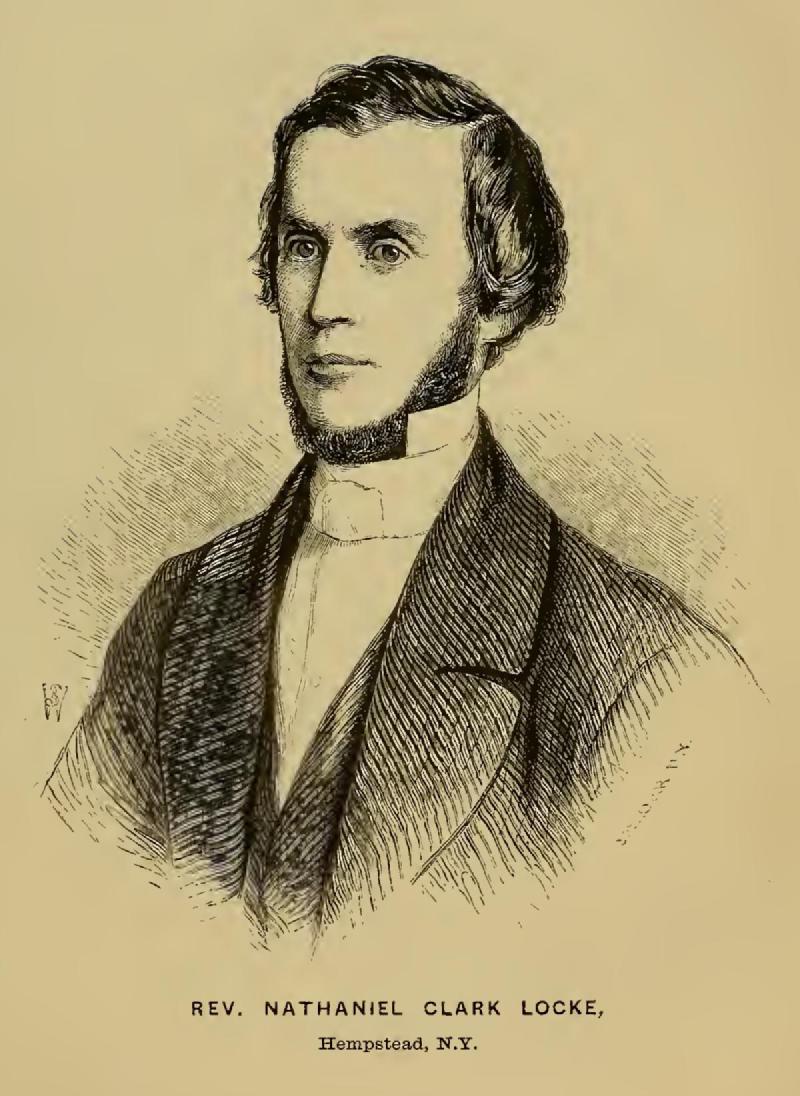
— 1853, John Goodwin Locke, Book of the Lockes: A Genealogical and Historical Record of the Descendants of William Locke, of Woburn., James Munroe and Company, Boston MA, p294. View largest available size.
There are striking similarities between the Illustration, Grandfather, and Souvenir images, including the widows peak, the hair swept forward over the ears, the Amish style beard, the upturned shirt collar with rounded ruffles in front. And of course, all the strong facial features and the penetrating gaze appear to match.
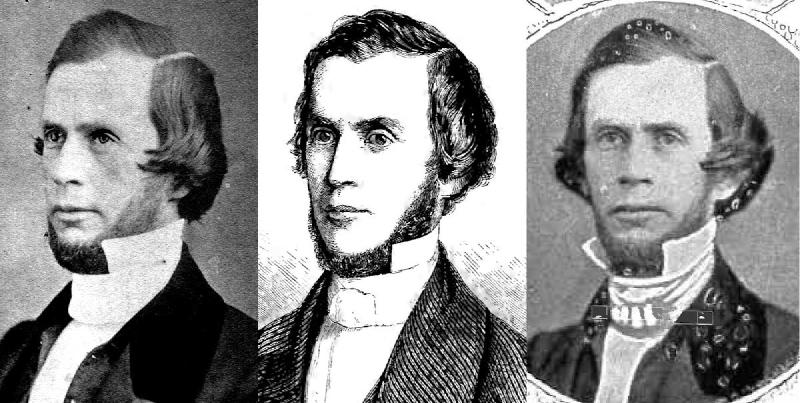
The main visual difference I can see between the Illustration and both the Grandfather and Souvenir photographs is that the jacket collar is a uniform color and material in the Illustration, but is clearly two different materials in the photographs. I believe that this is simply a decision made by the artist in the process of converting a photograph into an illustration, which I will explore in more detail momentarily. For now, it is simply enough to acknowledge that reproducing the jacket collar faithfully would take away time better spent on facial details and would in fact be a visual distraction from the facial details.
I wanted to further explore the similarities between the Grandfather photograph and the Illustration, and decided to use a method of comparing photographs I had employed in the The Mills of Buffalo section. Despite the obvious challenges of comparing a photograph and an illustration that came from very different primary sources and that have faces that are oriented differently, the comparison was surprisingly illuminating.
My basic method is to ensure proper scale by initially aligning pupils between two images: I start with one of the images as my base, and put a copy of the second image to the right and below the first, and scale both copies of the second image until pupils align both vertically and horizontally. I then copy the base image to the bottom right, so the pupils align. Creating an alternating 2x2 matrix of pairs of the images being compared not only makes direct comparisons in a static environment more convenient, but it also visually proves that the paired copies are at the same scale, and so, the viewer is demonstrably not in danger of being misled by comparing images at different scales. I then draw perfectly straight vertical and horizontal lines to see if any other facial features align, if the heads are the same shape and proportion, etc., ultimately creating a grid distinct to those paired images, that can be used to judge similarity.
In the Buffalo Mills comparison, the portraits faced the same angle nearly exactly, and so, I was able to align and scale the photographs for proper comparison based on aligning both sets of pupils, based on my manual estimation. Because the faces in Grandfather and Illustration are oriented differently, I am not able to scale based on two reference points. As it turns out, this is not necessary. In the comparisons that follow, understand that I am using the images extracted from their scanned sources at the same resolution, and at their original scale. It just so happens that both Grandfather and Illustration are at the same exact, or very nearly exact, scale, and I will attempt to explain why.
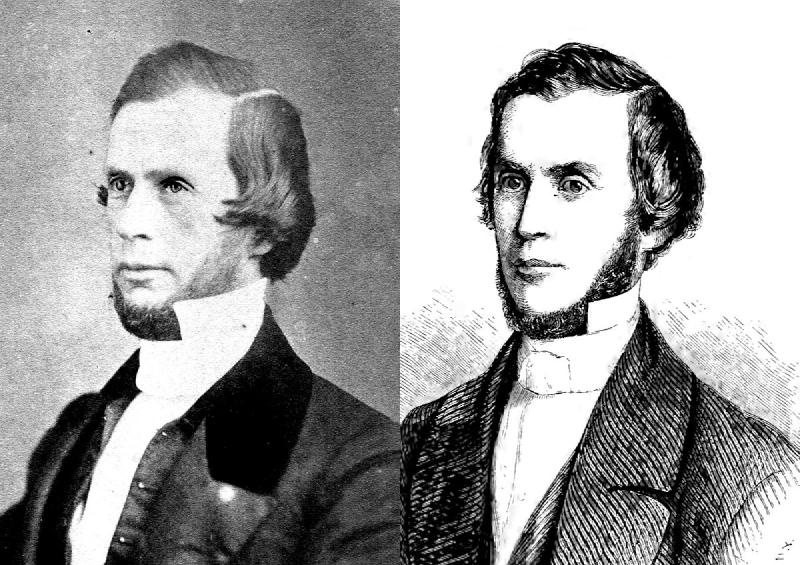
For purposes of alignment only, I chose each subject’s left eye (on the right side of the photograph as viewed):
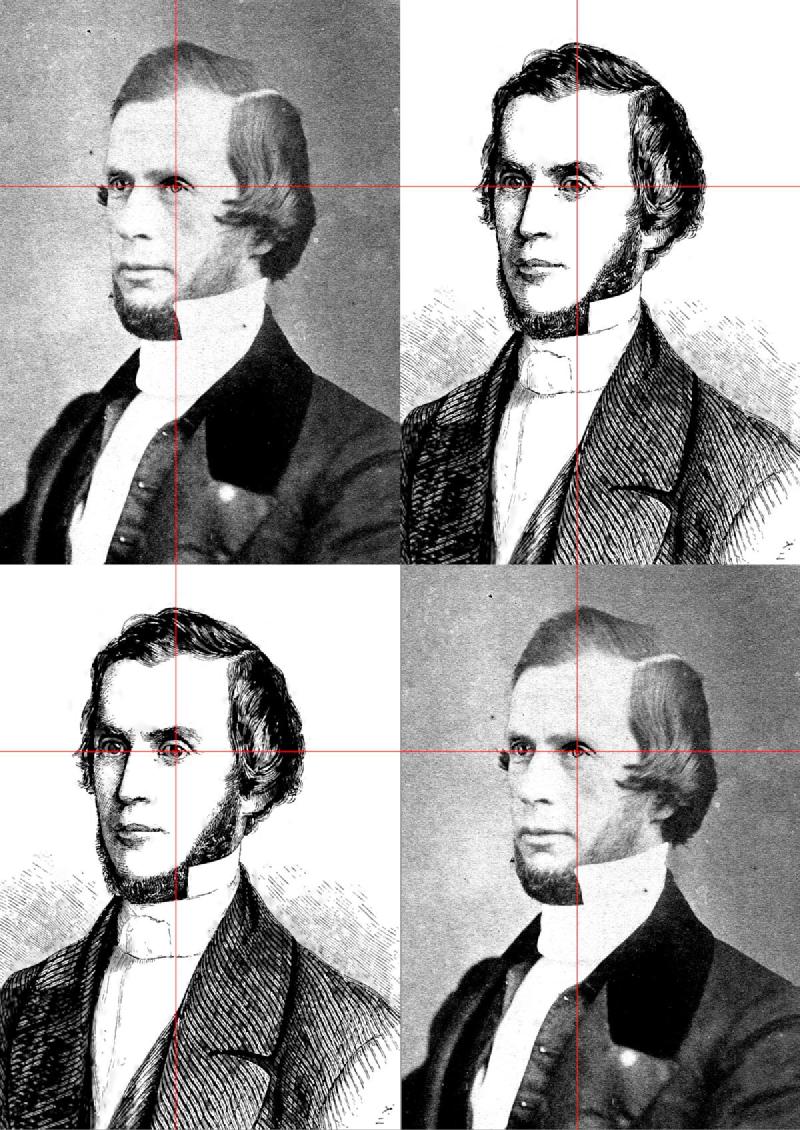
Already I will point out a compelling aspect of the images, the very slight upward placement of the right eye relative to the left. Now, a grid that highlights the edges of the features already identified as common to each image as well as other important facial features:
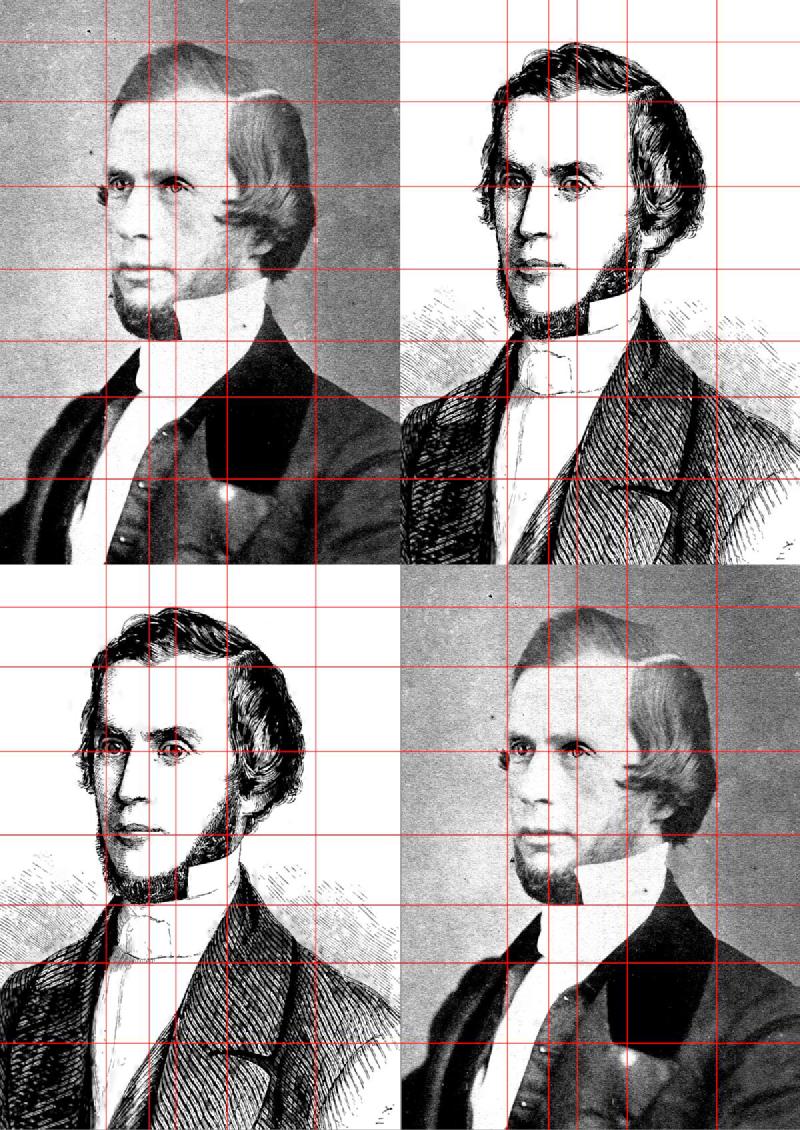
To my surprise, the Grandfather photograph, identified as Luther Loper, and the Illustration of Reverend Locke, taken from different sources at their original scales, appear to match closely, and where they differ, it is exactly where and how you would expect them to differ based solely on the fact that the faces are oriented to the camera differently. Notice for example, that where the head in the Illustration is offset from that in Grandfather on the left side, there is a corresponding offset on the right side that accounts for it, as easily seen when comparing the two images based on aligning the edges of a roughly minimal bounding box of the two heads, instead of aligning on the left pupil, and seeing that their widths and heights closely match:
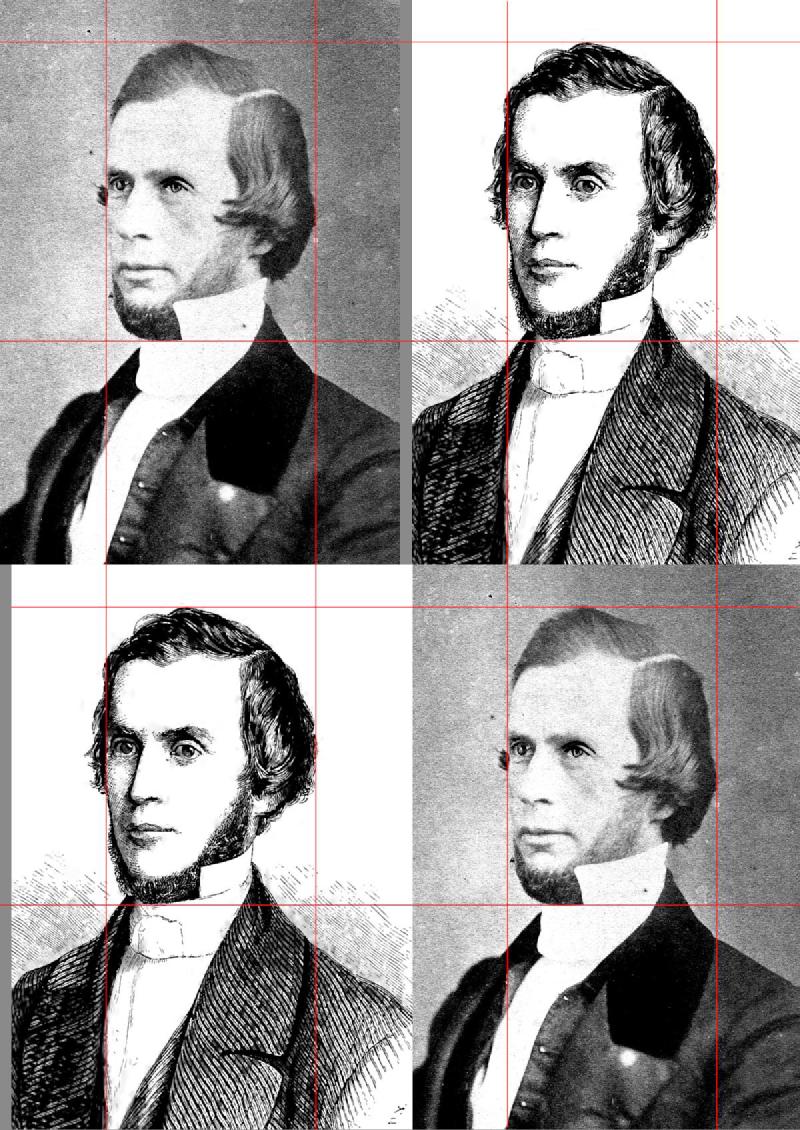
This comparison suggests to me that the Illustration was based on another exposure of Reverend Locke taken in the same sitting as the Grandfather photograph (and Souvenir), with Locke turning slightly to his left in each subsequent exposure, and it would appear to the same degree between each of the three known images, strongly suggesting they are consecutive exposures in order starting with Grandfather, then Illustration, then Souvenir.

I believe I can provide a valid narrative explanation for the origin of the Illustration that fits the known facts presented, but I must stress that what follows is my conjecture as to what actually occurred.
First, understand that Book of the Lockes (hereafter: BotL) was published in 1853, which was in both Luther Loper’s and Reverend Locke’s lifetimes, and in the forward, “To My Kinsfolk”, John Locke wrote on 01 Jan 1853 that “seven years of labor are over…I hope the time spent has not been entirely in vain…” (BotL, p5.)
Having examined a number of family genealogies, including their source material, I have seen a number of response letters to inquiries from the compilers of those genealogies. During this timeframe, there were well established postal routes between Boston where John Locke lived and the greater New York City area where Reverend Locke lived. Apparently, John Locke knew of, or came to know of, Reverend Locke, and it was presumably the Reverend himself who responded to an inquiry letter from John Locke, likely confirming or correcting purported information, offering updates, and providing his own brief biography and a recently printed calotype photograph. These events happened after Reverend Locke moved to Hempstead, as his biography in BotL references his 04 Dec 1850 installation over Christ’s First Presbyterian Church.
And here it may be appropriate to underscore that all three images under consideration are closely associated with Hempstead NY in different ways, and no other place, greatly informing the likely timeframe. Furthermore, if the images are of Reverend Locke, we can assume that they were taken within the first few years of moving to Hempstead based on his late 1850 installation in Hempstead and the publication of Book of the Lockes in 1853, and it is in fact the publication of the Illustration along with Locke’s biography in BotL that seems to most strongly indicate that the photographic sitting that produced all three images of Reverend Locke were most likely taken on the same day in 1851 or 1852.
The Illustration is a woodcut. In 1853, the technology to reproduce a photograph in a printed book or magazine involved using various tools and techniques to draw the image on a block of wood that was then used as a guide for an engraver to carve the image into the wood surface. The engraved woodblock was then inked and printed using a relief press, similar to the printing of type at the time. (See 1974, Estelle Jussim, Visual Communication and the Graphic Arts: Photographic Technologies in the Nineteenth Century, R.R. Bowker Company, NY.)
Woodcut is a relief printing technique in printmaking. An artist carves an image into the surface of a block of wood—typically with gouges—leaving the printing parts level with the surface while removing the non-printing parts. Areas that the artist cuts away carry no ink, while characters or images at surface level carry the ink to produce the print. The block is cut along the wood grain (unlike wood engraving, where the block is cut in the end-grain). The surface is covered with ink by rolling over the surface with an ink-covered roller (brayer), leaving ink upon the flat surface but not in the non-printing areas.
— Woodcut, Wikipedia.org.
There are also identifying marks on the Illustration woodcut, the most prominent:

— 1853, John Goodwin Locke, Book of the Lockes: A Genealogical and Historical Record of the Descendants of William Locke, of Woburn., James Munroe and Company, Boston MA, p294. View largest available size.
A similar mark from another illustration in BotL is clearer:

— 1853, John Goodwin Locke, Book of the Lockes: A Genealogical and Historical Record of the Descendants of William Locke, of Woburn., James Munroe and Company, Boston MA, p122. View largest available size.
This identifies the engraver as John William Orr, “one of the best known wood engravers of his generation.” (1958, Sinclair Hamilton, Early American Book Illustrators and Wood Engravers 1670-1870, Princeton University Press, Archive.org.) As a result, the woodcuts in BotL have their own cultural significance distinct from their inclusion in the Locke genealogy.
John William Orr (1815–1887) commonly known as J. W. Orr, was an Irish-born American wood engraver who drew many of his own illustrations and owned his own engraving and printing business. He was born in Ireland on March 31, 1815, and was brought to Buffalo, New York in his infancy. In 1836, he completed his instruction in drawing and engraving in New York City under the distinguished William Redfield. He returned to Buffalo, where he practiced wood-engraving and published several illustrated books, including Orr’s Pictorial Guide to Niagara Falls (1842), for which he designed and engraved the illustrations. He went to Albany, New York in 1842 as artist and engraver for The Country Gentleman and while there was awarded a gold medal for the best engravings of animals. In 1844 he settled in New York City, where his first employment was on Harper Brothers’ Illustrated Shakespeare. It was not long before he had his own business, a wood-engraving and printing establishment at 75 and 77 Nassau Street, New York. An advertisement of around 1857 states that he specialized in “illustrated catalogues and ornamental show cards”, and manufactured “illuminated envelopes”. His son, Louis Herbert Orr, was a successful typographer.
— J.W. Orr, Wikipedia.org.
A city directory of the time states that J. W. Orr’s engraving business “is the largest establishment of the kind in the City”. (1855, John F. Trow, Trow’s New York City Directory, p639, archive.org.) and in an advertisement in the same publication, J. W. Orr claims “this is the largest establishment in America. The finest and best work is done here.” (Ibid., pV.) Nassau Street is the Financial District of Manhattan, and in the 1850’s was known for its book stores, particularly used and rare books. Orr was also surrounded by many publishing and paper related businesses as well as many lawyers’ offices.

ENGRAVING.
The Subscriber respectfully informs the public that he still continues the business of WOOD ENGRAVING, in all its branches, at his old place, 75 Nassau Street, where, with his long experience and superior advantages, he is enabled to execute all orders in his line, however large, in a SUPERIOR STYLE, with the utmost dispatch, and on reasonable terms. His facilities for doing all kinds of work are unsurpassed. Orders by express or telegraphy promptly attended to.
J. W. Orr,
75 Nassau Street,
New-York.
— 04 July 1851, United States Post-Office Guide, D. Appleton & Company, New York NY, p24, archive.org. View largest available size.
The following advertisement for Orr’s firm in The Literary World, which was printed at nearby 109 Nassau Street, is adjacent to “publisher and bookseller” James Munroe & Co. of Boston, the publisher of Book of the Lockes. James Munroe is himself a Locke descendant, and he is recorded as entry 747, p240, BotL.
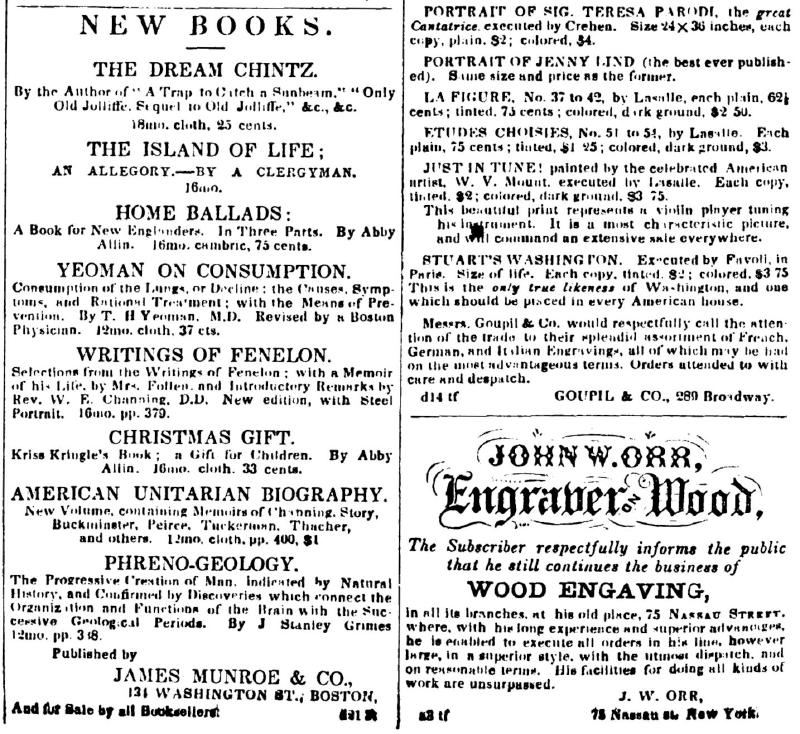
John. W. Orr, Engraver on Wood,
The Subscriber respectfully informs the public that he still continues the business of WOOD ENGRAVING, in all its branches, at his old place, 75 Nassau Street, where, with his long experience and superior advantages, he is enabled to execute all orders in his line, however large, in a superior style, with the utmost dispatch, and on reasonable terms. His facilities for doing all kinds of work are unsurpassed.
J. W. Orr,
75 Nassau st. New York.
— 04 Jan 1851, The Literary World; A Journal of Science, Literature, and Art, E.A. & G.L. Duyckinck, 100 Nassau Street, New York NY, v8, p18, Books.google.com. View largest available size.
It should also be noted that John Orr was known to work with his younger brother Nathaniel from 1844 to 1846, and Nathaniel Orr advertised his engraving firm on p14 of the same issue of The Literary World, with its location on 151 Fulton Street. In Wilson’s Business Directory of New York City in 1853, Nathaniel’s firm is located at 52 John Street. (John F. Trow, Printer and Publisher.) Many examples of wood engravings by both men are owned by Princeton University Library and the University of Florida George A. Smathers Libraries Special and Area Studies Collections.
It may also be relevant to point out that I have seen two different scanned versions of Book of the Lockes, that have the same publication date, and as far as I can tell from a cursory inspection, the only apparent difference between them is a change in the author’s woodcut, and the addition of one for his wife. Although the publication date is the same, I think we can reasonably assume that John Locke would have updated the book to add his wife, not remove her! The relevant information on Reverend Locke for example, appears unchanged, however, be aware there are potentially other editions of the book that may not be obvious.
Additionally, John Locke’s wife Jane was a published poet of some renown. Her maiden name was Starkweather, and John and Jane spent two years in Buffalo in the early 1830’s. J. W. Orr’s family lived in Buffalo at this time, although Orr may have been studying in New York City at that precise time. (I have reached out to Corfu Village Historian Allan Starkweather to see if he is a descendant of Jane’s family. TODO: follow-up)
The Illustration also has another artist’s mark that the other woodcuts in BotL do not have:
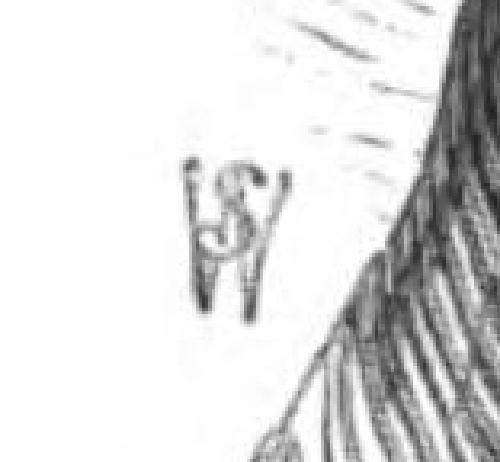
— 1853, John Goodwin Locke, Book of the Lockes: A Genealogical and Historical Record of the Descendants of William Locke, of Woburn., James Munroe and Company, Boston MA, p294. View largest available size.
I have matched this to other known works from the same time period of a “draughtsman”, or illustrator, of national renown, Samuel Wallin (1811 to 17 Apr 1883), who closely collaborated on many works over a number of years with J.W. Orr.
In both Europe and East Asia, traditionally the artist only designed the woodcut, and the block-carving was left to specialist craftsmen, called formschneider or block-cutters, some of whom became well known in their own right. …The formschneider in turn handed the block on to specialist printers. There were further specialists who made the blank blocks.
This is why woodcuts are sometimes described by museums or books as “designed by” rather than “by” an artist; but most authorities do not use this distinction. The division of labour had the advantage that a trained artist could adapt to the medium relatively easily, without needing to learn the use of woodworking tools.
— Woodcut, Wikipedia.org.
In their collaborations, it is common to see this terminology employed, with such phrases as “J.W. Orr after an illustration by Samuel Wallin” or more simply, “J.W. Orr after Samuel Wallin”. Often the draughtsmen that were associated with engravers were themselves called engravers, as evidenced by Wallin’s city directory entries: In 1850: “Wallin Samuel, engraver, 127 Fulton”. (Doggett’s New York City Directory for 1850-1851, p523, Archive.org.) And in 1855: “Wallin Samuel, draughtsman, 19 Beckman, h. 68 E 12th” and on the very next line: “Wallin Samuel H. engraver, 19 Beekman, h. Bedford av. Brooklyn” (01 May 1856, Trow’s New York City Directory, p854, Archive.org.) I have seen a similar lack of distinction when draughtsmen associated with lithography are referred to as “lithographers”.
Lithography (from Ancient Greek λίθος (líthos) ‘stone’ and γράφω (gráphō) ’to write’) is a planographic method of printing originally based on the immiscibility of oil and water. The printing is from a stone (lithographic limestone) or a metal plate with a smooth surface. …Traditionally, the image to be printed was drawn with a greasy substance, such as oil, fat, or wax onto the surface of a smooth and flat limestone plate. The stone was then treated with a mixture of weak acid and gum arabic (“etch”) that made the parts of the stone’s surface that were not protected by the grease more hydrophilic (water attracting). For printing, the stone was first moistened. The water adhered only to the gum-treated parts, making them even more oil-repellant. An oil-based ink was then applied, and would stick only to the original drawing. The ink would finally be transferred to a blank sheet of paper, producing a printed page. This traditional technique is still used for fine art printmaking.
— Lithography, Wikipedia.org.
By the mid-1840’s, Wallin was already recognized as an amateur illustrator of exceptional skill, and during the approximate timeframe of 1850 to 1855, Wallin solidified his professional reputation–”famed for his execution of heads”–through a close collaboration with J.W. Orr on many illustrations that accompanied the biographies of early American historical figures compiled by Abner Dumont Jones (02 Apr 1805 to 30 Jun 1872), the son of the early church reformer Elder Abner Dumont Jones (28 Apr 1772 to 29 May 1840). Wallin went on to work for Harper’s Magazine (launched in 1850) before finding his greatest success in 1860 when he began a decades-long relationship with Frank Leslie’s Illustrated Newspaper (launched in 1855).
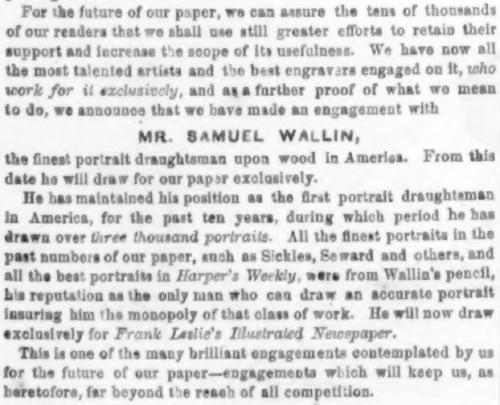
For the future of our paper, we can assure the tens of thousands of our readers that we shall use still greater efforts to retain their support and increase the scope of its usefulness. We have now all the most talented artists and the best engravers engaged on it, who work for it exclusively, and as a farther proof of what we mean to do, we announce that we have made an engagement with
MR. SAMUEL WALLIN,
the finest portrait draughtsman upon wood in America. From this date he will draw for our paper exclusively.
He has maintained his position as the first portrait draughteman in America, for the past ten years, during which period he has drawn over three thousand portraits. All the finest portraits in the past numbers of our paper, such as Sickles, Seward and others, and all the best portraits in Harper’s Weekly, were from Wallin’s pencil, his reputation as the only man who can draw an accurate portrait insuring him the monopoly of that class of work. He will now draw exclusively for Frank Leslie’s Illustrated Newspaper.
This is one of the many brilliant engagements contemplated by us for the future of our paper—engagements which will keep us, as heretofore, far beyond the reach of all competition.
— 04 Feb 1860, Frank Leslie’s Illustrated Newspaper, n218, vIX, p146, archive.org. View largest available size.
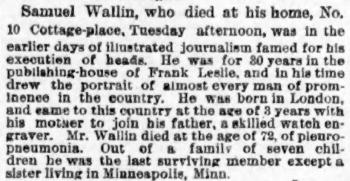
Samuel Wallin, who died at his home, No. 10 Cottage-place, Tuesday afternoon, was in the earlier days of illustrated journalism famed for his execution of heads. He was for 30 years in the publishing-house of Frank Leslie, and in his time drew the portrait of almost every man of prominence in the country. He was born in London, and came to this country at the age of 3 years with his mother to join his father, a skilled watch engraver. Mr. Wallin died at the age of 72, of pleuropneumonia. Out of a family of seven children he was the last surviving member except a sister living in Minneapolis, Minn.
— 19 Apr 1883, New York Times, New York NY, p5, newspapers.com. View largest available size.

SAMUEL WALLIN.
Samuel Wallin, the artist, died at his home at No. 10 Cottage-place on Tuesday afternoon of pleuropneumonia. Mr. Wallin was born in London, in 1811, and was the son of Samuel Wallin, once well-known as an engraver in this city. In childhood he displayed artistic ability, and at eighteen opened a store at No. 27 Chatham-st. as an engraver and artist, where he attracted the attention of the late Frank Leslie, with whom he engaged himself and remained over thirty years. Two years ago he opened an office at No. 7 Murray-st. He was a bachelor, and has made his home with his niece, Mrs. Halsey, for many years. The funeral will take place on Friday at 2 o’clock from his home.
— 19 Apr 1883, New York Tribune, New York NY, p5, newspapers.com. View largest available size.
Wallin, clever in his specialty, was much in demand, and drew all the heads in the “Illustrated American Biography” (1853-55), re-issued in 1867 as A. J. Jones’s “American Portrait Gallery.” He was better than J. A. Oertel, had more aplomb, but it is interesting to compare his portraits, always done with the same recognizable curves, manner more evident than characterization, with such a careful production as August Will’s portrait of Alexander Anderson, published in the “Child’s Paper”” in 1867.
– 1912, F. Weitenkampf, American Graphic Art, Henry Holt and Company, New York NY, p212, archive.org.
The Illustrated American Biography was a series, “complete in six volumes. Each volume will contain one hundred portraits, …one volume to be issued annually.” A. D. Jones’ preface “To The Public” in volume one is dated January 1, 1853 in New York, the exact date that John Locke gave in the preface to his genealogy in Boston. It isn’t until the third volume of Illustrated American Biography that the title page explicitly states: “Portraits Drawn by S. Wallin, and Engraved by J.W. Orr.” Later, in the American Portrait Gallery: “The portraits engraved on wood by J.W. Orr, from original drawings by S. Wallin.”
(Note that in 1850, photographer Mathew Brady published an album of portraits, The Gallery of Illustrious Americans.)
Typically, J.W. Orr’s mark was placed in the lower right quadrant of the woodcut, and Wallin’s mark was placed in the lower left quadrant, although there are a number of illustrations where I do not find Wallin’s mark, yet it appears to be his characteristic style, his “recognizable curves”. Note that many of the men’s jackets look very similar to Reverend Locke’s Illustration.
In the first volume, his mark was simply “S.W.”:

Sebastian Cabot.
— 1853, A. D. Jones, Illustrated American Biography, J. Milton Emerson & Co., New York NY, v1, p13, Google Books. View largest available size.
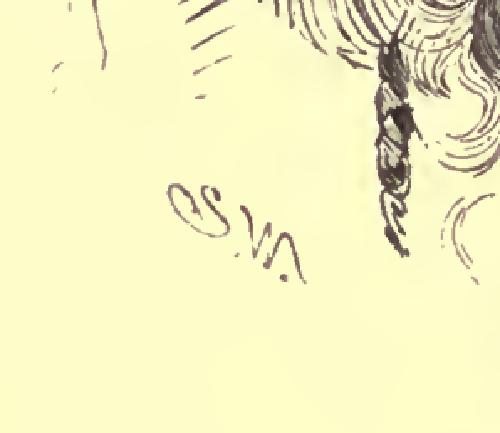
— 1853, A. D. Jones, Illustrated American Biography, J. Milton Emerson & Co., New York NY, v1, p13, Google Books. View largest available size.
But, beginning in the second volume published in 1854, the majority of the marks are in the overlapping style seen in the Illustration, although it should be noted, that even within these particular styles, the exact execution of each mark was unique to each woodcut.
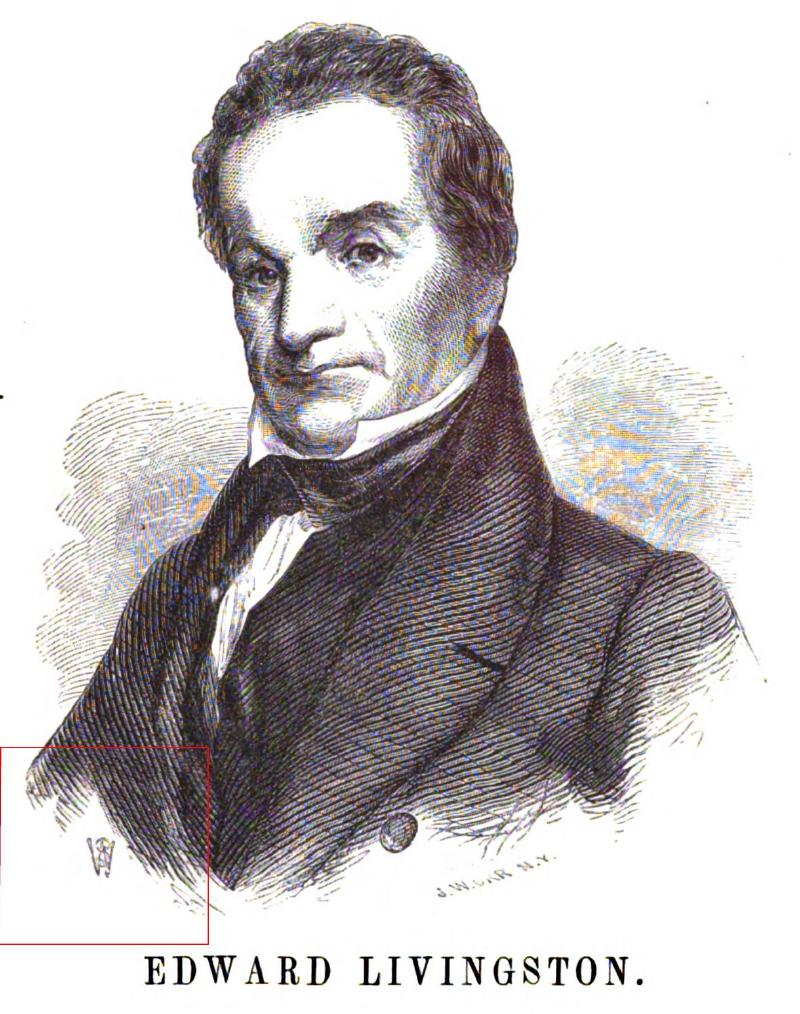
Edward Livingston
— 1854, A. D. Jones, Illustrated American Biography, J. Milton Emerson & Co., New York NY, v2, p415, Google Books. View largest available size.
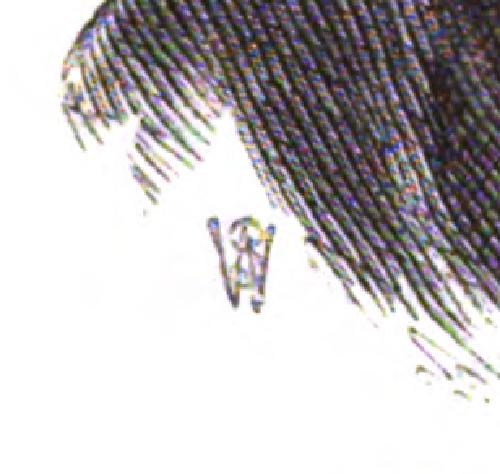
— 1854, A. D. Jones, Illustrated American Biography, J. Milton Emerson & Co., New York NY, v2, p415, Google Books. View largest available size.
It makes sense that the more ornate mark would be the newer one. Perhaps Wallin was looking for something more distinctive as his professional reputation grew.
So, it was Wallin that adapted the underlying Locke calotype for the Illustration. But how do we account for the apparent high degree of precision between Grandfather and Illustration? There are actually a number of tools and techniques for performing this type of reproduction, many of which predate photography itself. In the early 1850’s there was an inexpensive and readily available tool that was particularly noted for its high degree of precision, the camera lucida:
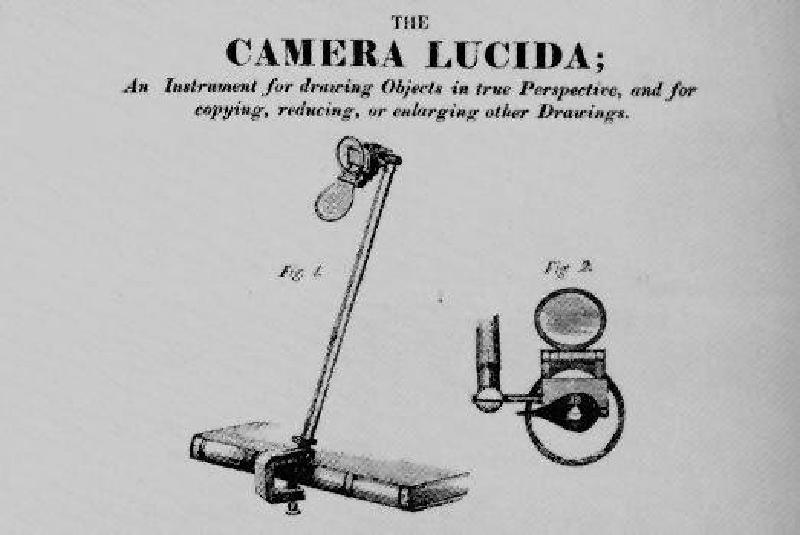
The CAMERA LUCIDA; An Instrument for drawing Objects in true Perspective, and for copying, reducing, or enlarging other Drawings.
— Ron Flynn, The Making of Audubon’s 1st Royal Octavo Edition of Birds of America using the Camera Lucida, Auduboninfo.net. View largest available size.
A camera lucida is an optical device used as a drawing aid by artists and microscopists. It projects an optical superimposition of the subject being viewed onto the surface upon which the artist is drawing. The artist sees both scene and drawing surface simultaneously, as in a photographic double exposure. This allows the artist to duplicate key points of the scene on the drawing surface, thus aiding in the accurate rendering of perspective. …The camera lucida was patented in 1806 by the English chemist William Hyde Wollaston.
— Camera lucida, Wikipedia.org
In my research into Samuel Wallin, I have not found sources that describe his specific methods, so I currently have no direct evidence for his possible use of a camera lucida. However, there may be indirect evidence its use.
While there are many surviving examples of portraits and other types of calotype subjects, the “painterly” nature of calotypes made them especially suitable for landscapes. Similarly, while the camera lucida could be and was used for reproducing photographs and other drawings, from my research, it appears that among the methods of the day, the camera lucida may have been uniquely capable of creating highly precise drawings of three dimensional objects and landscapes, and many descriptions of the camera lucida focus almost exclusively on this capability. (Recall that it was Talbot’s use of the camera lucida to reproduce a landscape that motivated the creation of the calotype process.) This emphasis initially led me to be skeptical of the use of the camera lucida to create the Illustration, because even though I had documentation that confirmed that the camera lucida could be used to reproduce two dimensional images, I initially had a difficult time finding a documented case of this type of application, until I discovered a very prominent and well documented use of the camera lucida from this general time period to reproduce highly detailed drawings as described in The Making of Audubon’s 1st Royal Octavo Edition of Birds of America using the Camera Lucida: “son John W. was assigned the job of reducing the double elephant sized Havell prints to the agreed on octavo size, using the Camera Lucida.” (Auduboninfo.net)
In the third volume Illustrated American Biography in 1855, there are two portraits that are different than all the others, as they are woodcuts of busts:
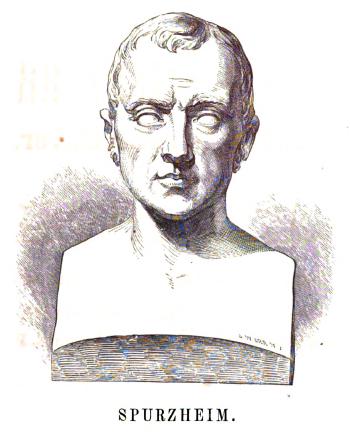
Spurzheim
— 1855, A. D. Jones, Illustrated American Biography, J. Milton Emerson & Co., New York NY, v3, p227, Google Books. View largest available size.
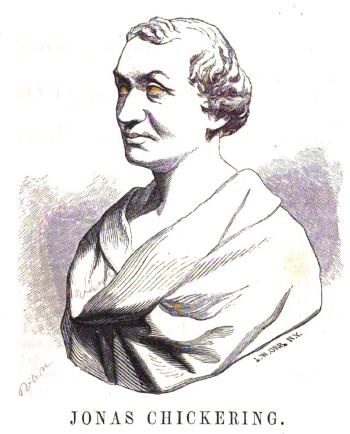
Jonas Chickering
— 1855, A. D. Jones, Illustrated American Biography, J. Milton Emerson & Co., New York NY, v3, p299, Google Books. View largest available size.
Obviously these could have been reproduced from photographs or other drawings of the busts, but there is at least the possibility that at least one of these woodcuts may have been based on a three dimensional physical artifact, reproduced using a camera lucida.
It should also be noted that Wallin’s mark is absent on these portraits, but there are a number of other portraits that either don’t have his mark, or have alternate marks than both Wallin and Orr. (The image of Jonas Chickering appears to have writing on it that I believe may not be part of the original work. So far, I have only seen a single digitized version of this volume, so I would want to compare it against another physical copy, or a digital version based on a different underlying physical copy of the volume.)
For example, it is Nathaniel Orr who signs the woodcut of John P. Durbin, D.D., in v3, p283, and while I can’t locate Wallin’s mark in that illustration, it appears to be his characteristic work. For both Henry Russell in v3, p291, and Stephen Olin, D.D., LL.D., v3, p295, “N. Orr” and “S.W.” appear close together, and for Hon. Robert Rantoul, Jr. in v3, p339, the engraver is a man from Philadephia.
(For those woodcuts of Wallin’s style where his mark is missing, has he hidden his mark in the illustration?)
And when looking at woodcuts in the same general time period in publications like Harper’s and Frank Leslie’s, it is not uncommon to not find artists’ marks on woodcuts. So, despite Dumont’s claim that “Portraits Drawn by S. Wallin, and Engraved by J.W. Orr”, this may be a minor over-generalization. (Perhaps Nathaniel Orr was working on behalf of his brother, for example.) And despite the fact that not every woodcut has Wallin’s mark, many (all?) of those woodcuts without marks seem to reflect his characteristic style. I am a little less confident saying this about the bust portraits, which do seem a bit different from the other drawings, but then, this may be due to the nature of the physical item being reproduced being significantly different.
(Interestingly, Dumont’s works contained many advertisements for engravers and associated draughtsman, and in some cases clarifies their working relationships at the time. For example v3, p277, lists William Momberger at 52 John Street and his references include Nathaniel Orr and Charles Scribner among others. Also on v3, p289, J. Wells advertises as a draughtsman at 52 John Street. Recall that 52 John Street is Nathaniel Orr’s place of business in Wilson’s 1853 city directory.)
From my research, descriptions of specific illustration and engraving techniques are rare, and when they do appear, they often only go so far as to describe “tracing” a photograph, which could describe a number of techniques and tools that include the camera lucida. Perhaps the fact that Grandfather and Illustration appear to be at the exact same scale may be a clue to the reproductive technique used; perhaps in this situation, there were easier, more direct methods of reproducing the photograph than the camera lucida.
There were various methods of transferring the artist’s drawn design onto the block for the cutter to follow. Either the drawing would be made directly onto the block (often whitened first), or a drawing on paper was glued to the block. Either way, the artist’s drawing was destroyed during the cutting process. Other methods were used, including tracing.
— Woodcut, Wikipedia.org.
From its inception, photography could contribute a great deal to the creation of wood engravings such as this. Photographs could, most simply, serve as sources for illustrations, so that the artist who drew the image onto the woodblock could work from something other than a drawing or memory or the imagination. This was especially appealing for illustrations that needed to be appreciated for their accuracy, such as a portrait or any other picture that promised to deliver more information with closer scrutiny. By the 1850s it was not unusual to see wood-engraved illustrations cited as being “from” or “after” a photograph—such as one titled Grouse on Nest from the same Scribner’ article as the Davis engravings—claiming something of the veracity of photography even if the illustrations themselves really looked nothing like photographs (fig. 3).
That same decade saw the development of a new and much more direct use of photography in wood engraving. In a technique sometimes called “photoxylography,” whatever picture was to be engraved could be photographically printed directly onto the woodblock, freeing up artists to work in whatever medium they wished and removing the need for an intervening draughtsman.
— Apr 2007, Stephen P. Rice, Photography in Engraving on Wood, Commonplace: the journal of early American life, Commonplace.online.
To summarize, my theory is that Grandfather is actually a calotype of Reverend Locke, one of at least three exposures likely taken approximately 1851, after the Reverend moved to Hempstead in December 1850, and before the publication of the Locke genealogy in 1853. Perhaps the photographs were motivated by the Church’s desire to record the likeness of their new pastor, or perhaps the genealogy itself could have been a motivation for the photograph. Presumably the Reverend was contacted by John Locke and the Reverend supplied a calotype and updated biographical information for publication. Eventually the calotype was adapted by Samuel Wallin and engraved as a woodcut by John William Orr and printed in Book of the Lockes.
If my theory is correct, then the obvious implication is that Juliet’s positive identification of Grandfather as Luther Loper must be incorrect.
Before trying to explain how this might possibly be, I would like to underscore an earlier point made about the relative ages of Luther Loper and Reverend Locke. Consider these simple facts: if we agree that Grandfather is a calotype–and I believe I have provided compelling evidence of this fact–and we choose a period in the middle of the known date range for the peak use of calotypes (roughly 1844 to 1856)–for convenience, I will choose Jun 1850–then note that in that month, Luther Loper turned 70 years old, and Reverend Locke turned 35, exactly half Luther’s age. And so then I ask: does the subject of the Grandfather photograph look more like a man of (approximately) 70, or a man of (approximately) 35? Simply put, if Grandfather is a calotype, then I believe that fact alone is sufficient to disqualify Luther Loper as the subject captured.
(TODO: follow-up with historical society for John Locke’s materials and possible calotype used for Illustration?)
Juliett (Loper) Shepard (06 Jan 1845 to 02 Apr 1911), is the daughter of Elmira (Loper) Pine’s brother Erastus Harvey Loper (1813 to 05 Aug 1860). (Erastus also has a daughter named Elmira, later shortened to “Myra”, Elmira “Myra” A (Loper) Sinell (1849 to 1927).) Elmira Pine’s husband, Charles M. Pine is listed as a witness in the administrative records associated with Erastus H. Loper’s will. Charles M. Pine is Edward H. Mills’ mentor and business partner.
Juliett’s name is sometimes spelled “Juliet”, “Juliette”, and even mistakenly written as “Julia” (see 1855 New York State Census), but “Juliett” appears to be correct based on surviving letters. Juliett is discussed in relation to the Pine family in both the Hempstead and Staten Island sections, but I will provide here a few facts about her life:
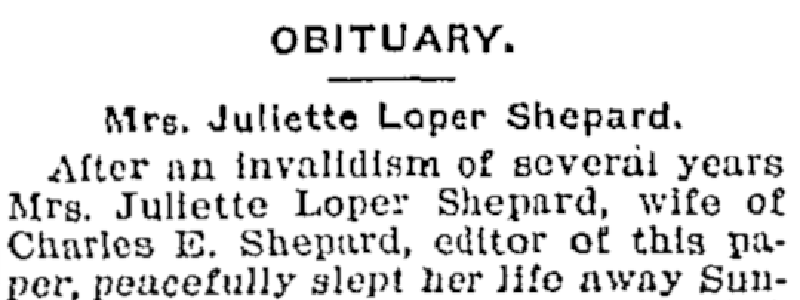
OBITUARY.
Mrs. Juliette Loper Shepard.
After an invalidism of several years Mrs. Juliette Loper Shepard, wife of Charles E. Shepard, editor of this paper, peacefully slept her life away Sunday morning at 9:30 o’clock. She died from paralysis, having had several shocks previous to the one Friday morning, which finally terminated in her death. Mrs. Shepard was born in Farmingdale, L. I. January 6, 1845, being the daughter of Erastus H. and Caroline Loper. Her early life was spent in New York City, and following the death of her father in 1860 the family moved to this place. She was married to Mr. Shepard November 28, 1872, and three children were born to them. George, the only son, died in childhood, and the other two survive, They are: Caroline, wife of Raymond S. Spears of Little Falls, N. Y., and Jessie L., an instructress in an institution for the blind in New York City. Mrs. Shepard also leaves two sisters, Mrs. William Sinell of Spring Valley, N. Y.; Mrs. Walter E. Bryant of this village, and two brothers, Edward H. Loper and William H. Loper, also of Huntington.
Early in life Mrs. Shepard united with the First Presbyterian Church and later, upon the inception of the Central Presbyterian Church, joined that organization. There are very few members, if any, who have been as devoted to the work of the church as Mrs. Shepard. As long as her health permitted she was a faithful attendant upon its services, and when she was unable to go her thoughts were centered upon the things of God’s house. Being enthusiastic upon the subject of missions, she was many years secretary and treasurer of the Ladies’ Missionary Society of the Central Presbyterian Church. Even up to the day of her death she was formulating plans along missionary lines. Her heart went out to the poor and many a local family will miss her little acts of kindness which she did without show or ostentation.
She was for many years a member of Dorcas Circle of King’s Daughters of this village, which sent a large number of gifts to the miners in Michigan and to the sick in hospitals and tenements, and she continuously sent supplies to city missions. She was also for many years an active worker for temperance in the ranks of the W. C. T. U, and a member of Ketewamoke Chapter, D. A. R.
The funeral services were held at the Central Presbyterian Church Tuesday afternoon at 2 o’clock, the Rev. Samuel H. Seem being in charge. The interment was in the Huntington Rural Cemetery.
H. A. B.
Mrs. Raymond S. Spears and two sons, Charles and John of Little Falls, N. Y., have been spending the week at the Shepard home on West Neck avenue, having been called here by the illness and death of Mrs. Spears’ mother.
— 07 Apr 1911, The Long Islander, Huntington NY, p4, nyshistoricnewspapers.org. View largest available size.
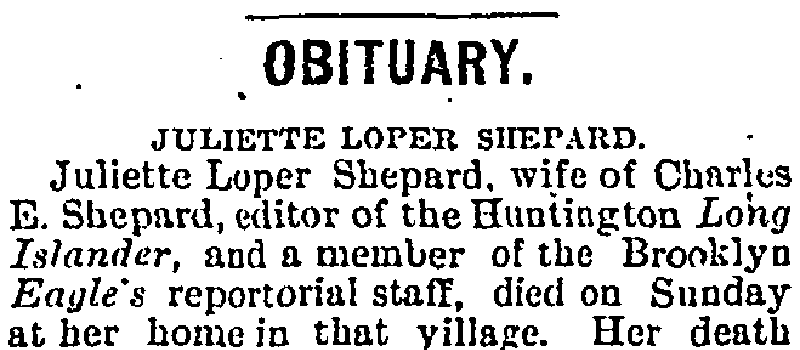
OBITUARY.
JULIETTE LOPER SHEPARD.
Juliette Loper Shepard, wife of Charles E. Shepard, editor of the Huntington Long Islander, and a member of the Brooklyn Eagle’s reportorial staff, died on Sunday at her home in that village. Her death terminated a long period of failing health, and ended a serious illness of some days. Mrs. Shepard was born at Farmingdale on January 6, 1845, and was the daughter of Erastus H. and Caroline Loper. Her childhood was spent in the City of New York and in 1860, following the death of her father, the family removed to Huntington. She was married to Mr. Shepard on November 28, 1872. Three children were born to them, of whom two survive, a son haying died in childhood. The surviving children are Caroline, wife of Raymond S. Spears of Little Falls, N. Y., and Jessie L. Shepard, an instructress in the Institution for the Blind, in Manhattan. Mrs. Shepard in early life became a member of the First Presbyterian Church and later was one of the first members of the Central Church of Huntington. She was active in the work of that organization, and was prominent in connection with the Woman’s Home and Foreign Missionary Society, of which she was for a long period secretary, She had a wide acquaintance, and was highly regarded. Funeral services were held from the Central Church on Tuesday afternoon.
— 07 Apr 1911, The Suffolk County News, Sayville NY, p4, nyshistoricnewspapers.org. View largest available size.
Both of Juliett’s obituaries indicate that she was born in Farmingdale Long Island 06 Jan 1845 and that “her childhood was spent in the City of New York and in 1860, following the death of her father, the family removed to Huntington.” The move to New York City appears to be in 1848, according to a user-supplied biography for Erastus on FindAGrave.com. I have contacted the user to verify the original source for this fact. (TODO: follow-up.)
The city directories from the 1850’s for Erastus Loper:
“Loper Erastus H. carman, 367 Sixth.” (1850, Doggett’s New York City Directory, p306, Archive.org.)
“Loper Erastus H. carman, 367 Sixth.” (1851, Doggett’s New York City Directory, p306, Archive.org.)
“Loper Erastus H. carman, h 259 Sixth” (1856, Trow’s New York City Directory, p498, Ancestry.com.)
“Loper Erastus H. carman, h 259 Sixth” (1857, Trow’s New York City Directory, p498, Ancestry.com.)
“Carman” is also Erasus’ occupation in both the 1850 Federal Census and 1855 New York State Census (Ancestry.org) and “cartman” in the 1860 Federal Census (Ancestry.org. Emphasis added.) (In the 1855 New York Census, Erastus is listed as “Eleazar H. Loper”.)
CARMAN, n. [car and man] A man whose employment is to drive a cart, or to convey goods and other things in a cart.
– 1828, Noah Webster, An American Dictionary of the English Language, p175, Archive.org.
Each of the referenced census entries for Erastus are taken in Ward 11 of New York City. In the 1850’s, Brooklyn, Queens, the Bronx and Staten Island were separate municipalities, and they were not merged into Greater New York until 1898. So, “New York City” in the 1850’s refers specifically to Manhattan.
11th Ward, from Rivington-st. N. to Fourteeth-st. bounded on the W. by Clinton-street and Avenue B, east by East River.
– 1833, Edwin Williams and Johjn Disturnell, New-York As It Is, p238, Archive.org.
Although I have not found maps from the period with street numbers, Ward 11 includes “(East) 6th Street”–not to be confused with Sixth Avenue to the west–for a few blocks before reaching the East River, in an area presently known as the Alphabet City section of the East Village neighborhood.
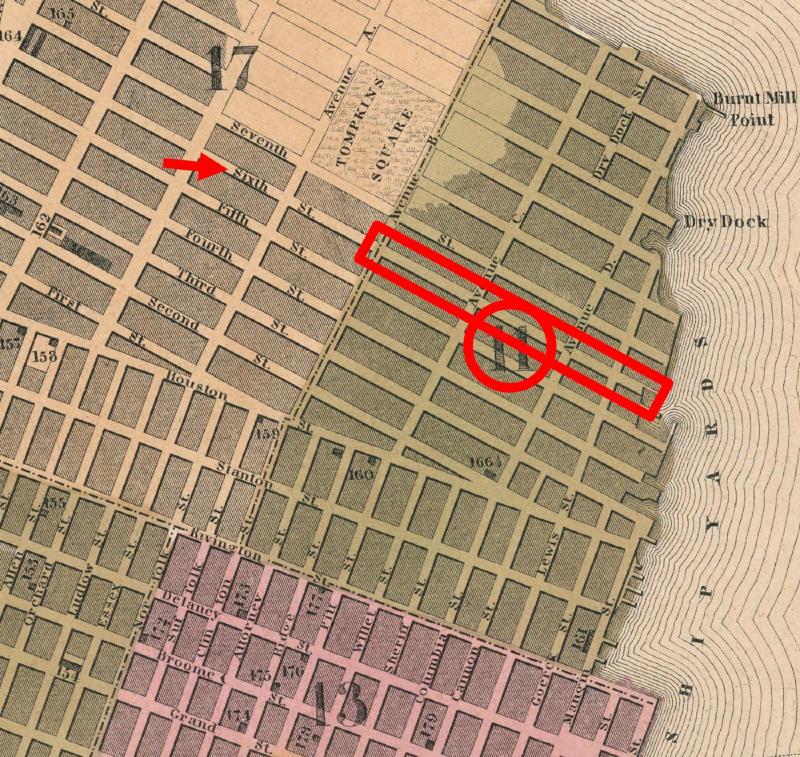
— 1848, Samuel Augustus Mitchell, City of New York, DavidRumsey.com. Cropped and annotated. View largest available size.
The Alphabet City area initially developed along the riverfront, during the 1820s, as part of the city’s expanding shipbuilding and repair industry. Shipyards tended to form tight clusters in close proximity to specialized workers, such as ship carpenters, and ancillary manufacturers, such as iron works.[65] They also required lots of cheap space. Hence, the city’s growth forced the shipyards to migrate periodically to peripheral sites: above Dover Street around 1750, below Corlears Hook (some five blocks south of Houston Street) around 1800, then, beginning in the 1820s, the marshes of Alphabet City. During the 1840s and 50s, the East River, from Corlears Hook to 13th Street, and inland as far as Avenue C, represented the greatest concentration of shipbuilding activity in the country.[68] After the Civil War, land and labor costs, along with the switch from wood to more massive iron hulls, would push the industry off the island entirely.
…As shipyards filled the riverfront, housing popped up nearby. In many cases, shipbuilders themselves played the role of developer. Noah Brown, for example, built a boardinghouse for apprentices south of Houston and invested in large plots to the north. Beginning around 1830, the Ficketts, another shipbuilding clan, built numerous three-story brick houses along Avenue D as well as cross streets west to Avenues C. They occupied some themselves and rented lesser variants to skilled laborers. By the early 1840s, shipyard owners dotted the neighborhood, and the majority of the city’s ship carpenters lived in a narrow strip of blocks along Avenue D and Lewis Street, a stone’s throw from the wharfs.
Throughout this period, the industry was dominated by in-migrants drawn to the booming shipyards from surrounding countryside and boatbuilding regions across New England. They shared a traditional production model in which artisans progressed from apprentices to journeymen to masters, all while living and working side by side. Sean Wilentz, who documented the sweatshop proclivities of antebellum New York City, points to shipbuilding as the rare industry where tradition persisted and kept wages, skill and respect generally high. He and others also credit shipyard workers with pioneering the reduction of work hours in the United States. A “Mechanics’ Bell” hung for decades along the Alphabet City riverfront to enforce the ten-hour day that journeymen secured around 1834. Labor reformer George McNeill likened it to a “‘Liberty Bell’ … for the sons of toil.”
– Alphabet City, Manhattan, Wikipedia.org.
The following image is said to show this area from the other side of the East River in 1848, the same year Erastus Loper’s family purportedly moved to New York City:

— The Miriam and Ira D. Wallach Division of Art, Prints and Photographs: Print Collection, The New York Public Library. “New-York and environs, from Williamsburgh.” The New York Public Library Digital Collections. 1848. https://digitalcollections.nypl.org/items/510d47d9-7c9b-a3d9-e040-e00a18064a99. View largest available size.
Perhaps Erastus was drawn to this area because, like his ancestors, he was adventurous, and “followed the sea”:
LOPER
Of the early settlers of East Hampton, only three families who remained here permanently were not English. These were from Holland, and one was the Loper family. The first Loper in America was Capt. Jacob (Jacobus) Loper, who came from Holland, served at Curacoa in the West Indies with Peter Stuyvesant as Captain-Lieutenant, and in 1646 was a member of the Council of Nieuw Amsterdam (New York). In 1647 he was commander of a Dutch man of war, permanently stationed in the harbor there; and in June of that year he was married to Cornelia, daughter of Cornelis Melyn, Patroon of Staten Island and at one time President of the Council in Nieuw Amsterdam. Cornelis Melyn, a man of wealth, had a fine residence at the corner of Pearl and Broad Streets in Nieuw Amsterdam.
Capt. Jacob Loper died in 1652, leaving two young children, Janneken and James. The next year his widow married Jacob Schellinger, a prosperous merchant; but in 1664 when the English conquered the New Netherlands, Schellinger with his wife and stepson removed to East Hampton, where young James Loper engaged with Jacob Schellinger in offshore whaling, and became so expert that in 1672 Nantucket, more newly settled than East Hampton, offered him a land grant if he would settle there and “carry on a designe of whale fishing.” He must have gone there briefly, for two Nantucket whaleships bore the name Loper and they began shore-whaling operations at about that time; but in 1674 he was back in East Hampton and married Elizabeth Howell, daughter of Arthur Howell and granddaughter of the first Lion Gardiner of Gardiner’s Island. It was the sixteen-year-old mother of Elizabeth Howell, Elizabeth, second daughter of Lion Gardiner, who, dying in 1657 a few days after the birth of her child, was said to have been done to death by the alleged witch, Goody Garlicke.
All of the Long Island Lopers and probably all the Lopers in this country are descended from James Loper the whaleman. James and Elizabeth had three children, Arthur, Lion, and Joanna. Their sons left East Hampton; but their grandson, another James, born in 1700, returned and settled in Amagansett, three miles east of the original settlement in East Hampton. Lopers are still living there, and nine men of the name were among the boat crews in Amagansett’s last shore-whaling days. Eugene, Lincoln, Jesse, Henry, Samuel, Daniel, Grant, Walter, and Abraham Loper helped to keep alive the family and village traditions.
The Lopers followed the sea, and they were adventurous. In deepsea whaling days, a Captain Loper was master of the whaleship Washington out of Sag Harbor, 1833; and of the Triad in 1837. David Loper was master of the Marcus, 1841, 42; of the Concordia, 1847, the Hamilton, 1848, and of the Excel, 1861. Jeremiah G. Loper was 3d mate of the bark Ocean when she cleared from Sag Harbor Aug. 10, 1866, never to be seen again. Lopers caught the gold fever when there was a general exodus to California. Albert Jagger of Southampton mentioned in his journal, 1850, seeing Henry Loper at Wolf Creek, California; and Capt. Charles Loper died July 1852 aged 38 on board the steamer Tennessee on the way to California.
– 1953, Jeannette Edwards Rattray, East Hampton History Including Genealogies of Early Families, Country Life Press, Garden City NY, p437-438, Books.google.com.
I believe the most likely way that Erastus Loper’s family might have travelled between New York City and Hempstead, was by taking the Long Island Rail Road (LIRR), which had a well established route from the western shore of Brooklyn to Hempstead before 1848.
Since its plan was not to serve local traffic on Long Island, the LIRR chose not to serve existing communities along the shores of the island, but built straight down the middle of the island, which was largely uninhabited at the time and relatively free of grade crossings. This straight route was the quickest and the easiest to build, compared to the options of building along the northern coast of Long Island, or in a north-central route following the Middle Country Road. The LIRR was organized on June 17, 1835, and Knowles Taylor was elected president.
– History of the Long Island Rail Road, Wikipedia.org.
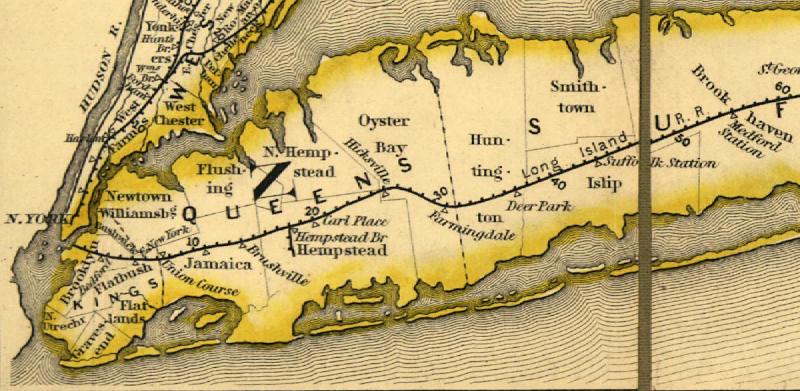
— 1849, J. H. Goldthwait, Railroad map of New England & Eastern New York., LCCN: G3721.P3 1849 .G6, ID: 98688377, Library of Congress. View largest available size.
It was not until 1883 that the Brooklyn Bridge opened, establishing a road connection across the East River from Manhattan to Brooklyn. Prior maps show several ferry routes over the East River, and in particular, the South Ferry (next to the Staten Island Ferry) took passengers from Whitehall Street in lower Manhattan to very near the Brooklyn terminus of the LIRR at Atlantic Street (later called “Atlantic Avenue”).
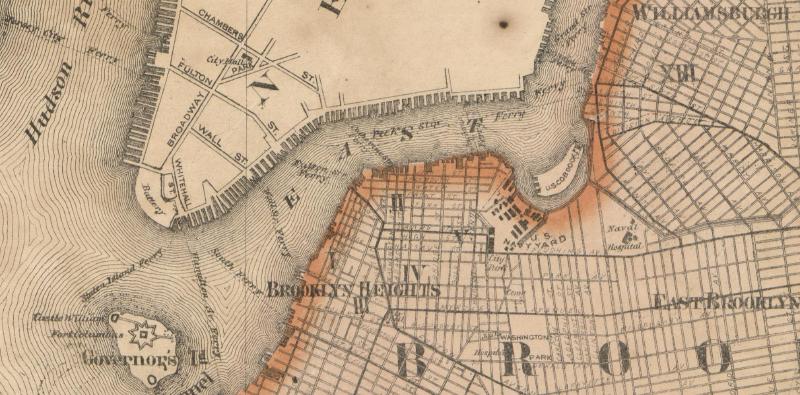
— 1859, Henry Francis Walling, Topographical map of the counties of Kings and Queens, New York, LLCN: 2013593266, G3804.N4:3B8 1859 .W3, Loc.gov. Cropped. View largest available size.
South Ferry was a ferry landing on the Brooklyn side of the East River, at the foot of Atlantic Avenue below the Brooklyn Heights neighborhood. It is now Piers 5 and 6 in Brooklyn Bridge Park.
…As the City of Brooklyn grew, the area south of Atlantic Avenue (known as “South Brooklyn”) began to become built-up, but lacked easy access to the ferry terminals in the northern parts of the city of Brooklyn. Thus, the South Ferry Company established the South Ferry on May 16, 1836, to connect Lower Manhattan to the foot of Atlantic Avenue in Brooklyn and the month-old Brooklyn and Jamaica Railroad – later the Atlantic Avenue Railroad’s streetcar line, and later still part of the Long Island Rail Road, now called the Atlantic Branch – through the Cobble Hill Tunnel. “South Ferry” is still the name of the area of lower Manhattan where the ferry’s landing was, and was also the name of the Brooklyn landing and ferry house, although the name is no longer in use.
The Fulton Ferry Company, which then operated only the Fulton Ferry, merged with the South Ferry Company in 1839 to form the New York and Brooklyn Union Ferry Company.
– South Ferry, Brooklyn, Wikipedia.org.
Using Google Maps’ walking directions in 2025 from East 6th Street near the East River to the Whitehall Street South Ferry Terminus, the distance is approximately three (whole) miles.
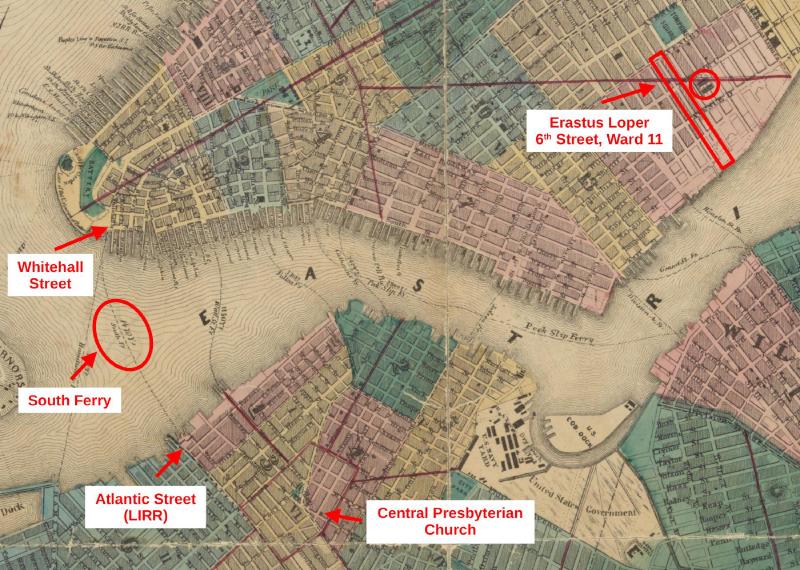
— Lionel Pincus and Princess Firyal Map Division, The New York Public Library. “Map of the cities of Brooklyn, Williamsburg, and Township of Bushwick.” The New York Public Library Digital Collections. 1850 - 1859. https://digitalcollections.nypl.org/items/c49406af-de89-378c-e040-e00a18064e88. Cropped and annotated. View largest available size.
The following images represent the South and Staten Island Ferries as Juliett might have known them in the early 1850’s:
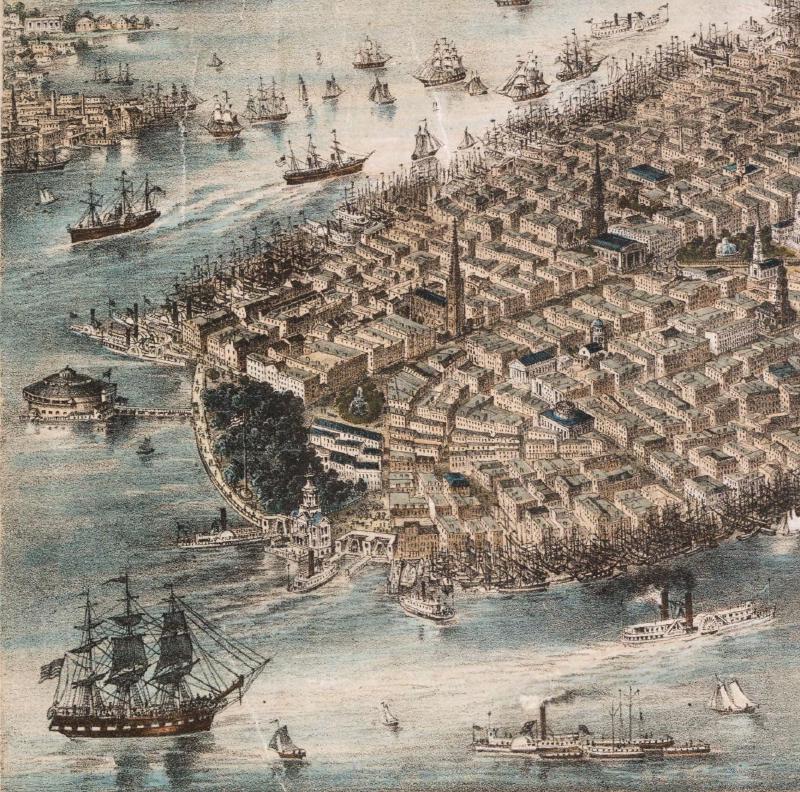
— The Miriam and Ira D. Wallach Division of Art, Prints and Photographs: Print Collection, The New York Public Library. “Souvenir of New York.” The New York Public Library Digital Collections. 1851. https://digitalcollections.nypl.org/items/efbf38c0-c5ed-012f-1270-58d385a7bc34. Cropped. View largest available size.
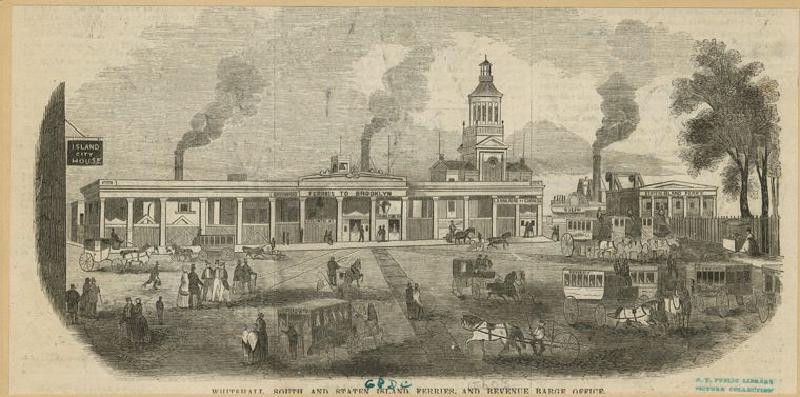
— The New York Public Library. “Whitehall South and Staten Island ferries, and Revenue Barge Office” The New York Public Library Digital Collections. 1853-09-24. https://digitalcollections.nypl.org/items/169c2170-c55d-012f-0797-58d385a7bc34. View largest available size.
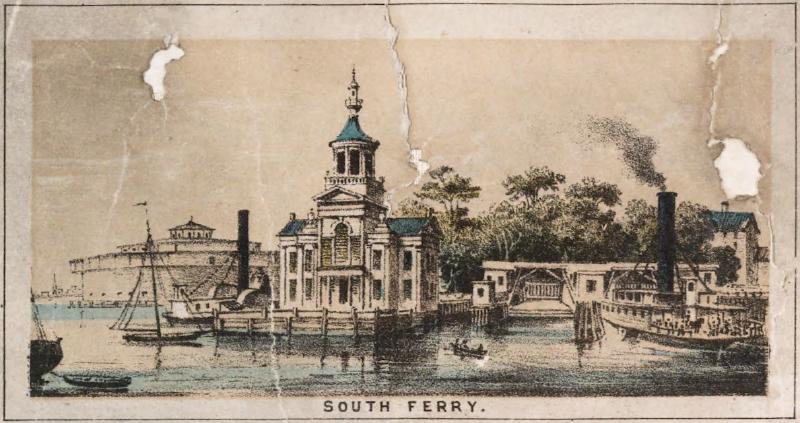
— The Miriam and Ira D. Wallach Division of Art, Prints and Photographs: Print Collection, The New York Public Library. “Souvenir of New York.” The New York Public Library Digital Collections. 1851. https://digitalcollections.nypl.org/items/efbf38c0-c5ed-012f-1270-58d385a7bc34. Cropped. View largest available size.
For a fascinating history of the Cobble Hill train tunnel on Atlantic Street (Avenue) in Brooklyn, that includes additional photographs of South Ferry and the Atlantic Avenue Depot, see The Tunnel, Arrts-arrchives.com. Also: Cobble Hill Tunnel.
The Lopers would then take the LIRR to the depot near Mineola that was originally called “Branch”, then “Hempstead Branch”, and finally, “Mineola” to take a “small dummy train” to Hempstead Depot, for many years, the only local destination of the LIRR. The Hempstead Depot was directly across the street from Christ’s First Presbyterian Church where Reverend Locke was pastor in the 1850’s. The following ticket from 1852 appears to show the destination is “Hempstead Branch”:
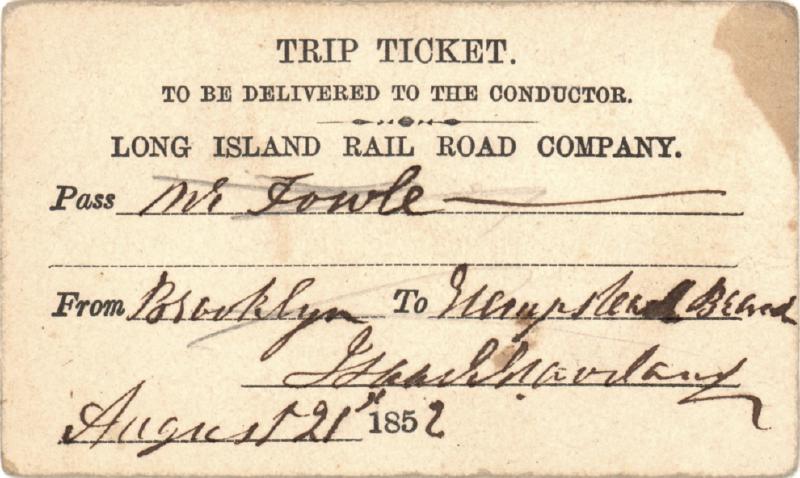
— 21 Aug 1852, from Hempstead, Arrts-arrchives.com. View largest available size.
On May 16, 1836, supplement to the charter authorized a branch to Hempstead, and surveying was done for the branch in 1838. The short Hempstead Branch, running south from the Main Line at Mineola, opened in July 1839 from Hempstead Branch station (later Mineola) down Main Street, terminating between Fulton Street and Centre Street. The branch was served using a small dummy train, shuttling passengers on the branch. The LIRR slowly extended east, reaching Farmingdale on October 18, 1841, and reaching Deer Park in 1842, which was the stopping place for the shore villages of Huntington and Babylon, even though they were miles away.
– History of the Long Island Rail Road, Wikipedia.org.
The Souvenir book mentions that in 1894, “the membership of the church is now over 300, and of this number between 30 and 40 reside in or near Mineola, where they have the privilege of attending service in the Union Chapel on Sunday evenings.” (p27.)
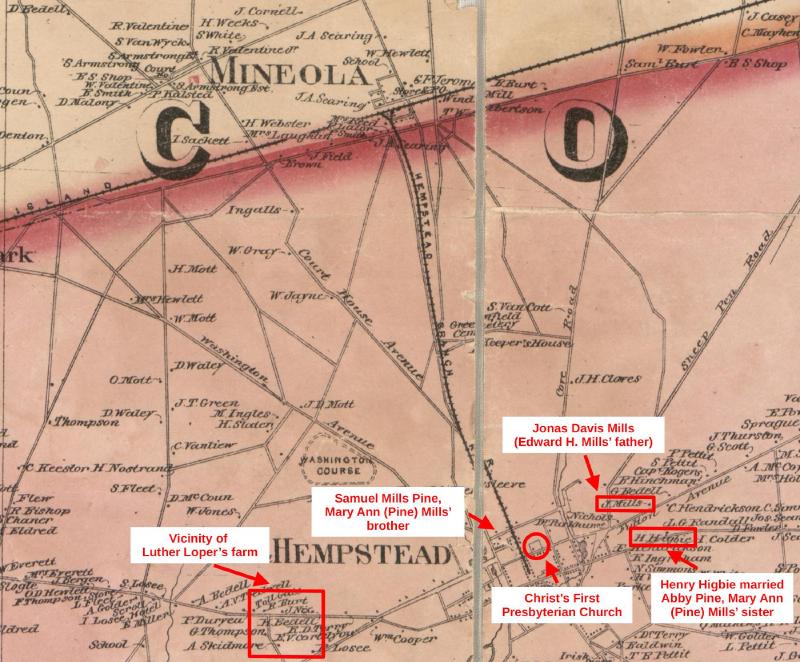
— 1859, Henry Francis Walling, Topographical map of the counties of Kings and Queens, New York, LLCN: 2013593266, G3804.N4:3B8 1859 .W3, Loc.gov. Cropped and annotated. View largest available size.
Most deeds, especially from the 1800’s, are not yet digitized as I write this, and so, it is not really possible for me to do deed research remotely. Yet, although Luther was not alive when the 1859 Walling map was made, several of his neighbors in 1850, as indicated by their relative proximately to Luther Loper in the 1850 Federal Census, are still clustered together on the Walling map, indicating the general vicinity of Luther Loper’s farm to the west of the village.
| Line Num | Head of Household | Occupation |
|---|---|---|
| 7 | Richard Burt | Farmer |
| 24 | Abram Skidmore | Farmer |
| 27 | Luther Loper | Farmer |
| 30 | Hiram Bedell | Farmer |
– 19 Aug 1850, United States Federal Census, Hempstead NY, p113, Ancestry.com.
Maps of Hempstead village showing the depot and the Presbyterian Church:
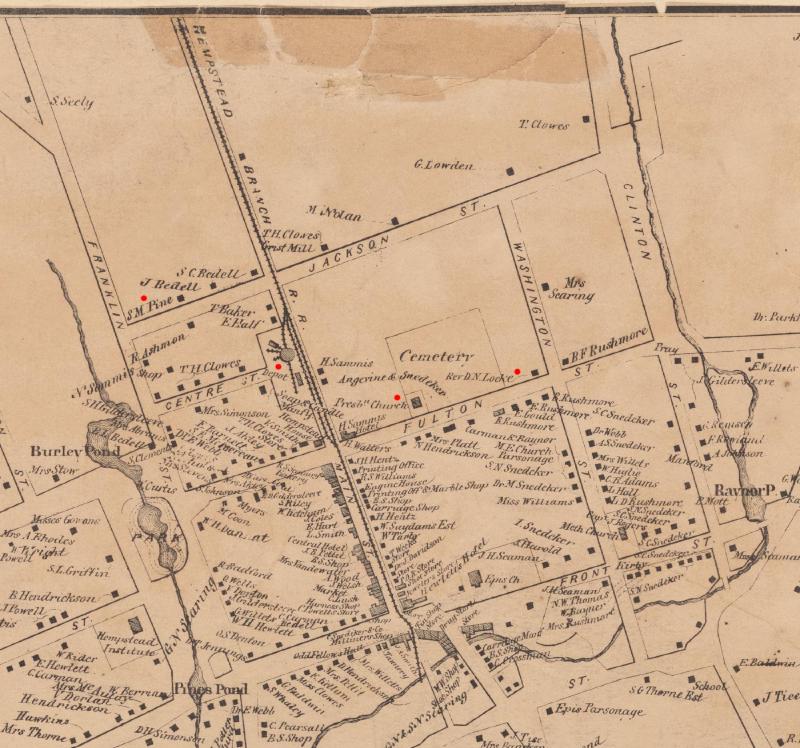
— 1859, Henry Francis Walling, Topographical map of the counties of Kings and Queens, New York, LLCN: 2013593266, G3804.N4:3B8 1859 .W3, Loc.gov. Cropped and highlighted. View largest available size.
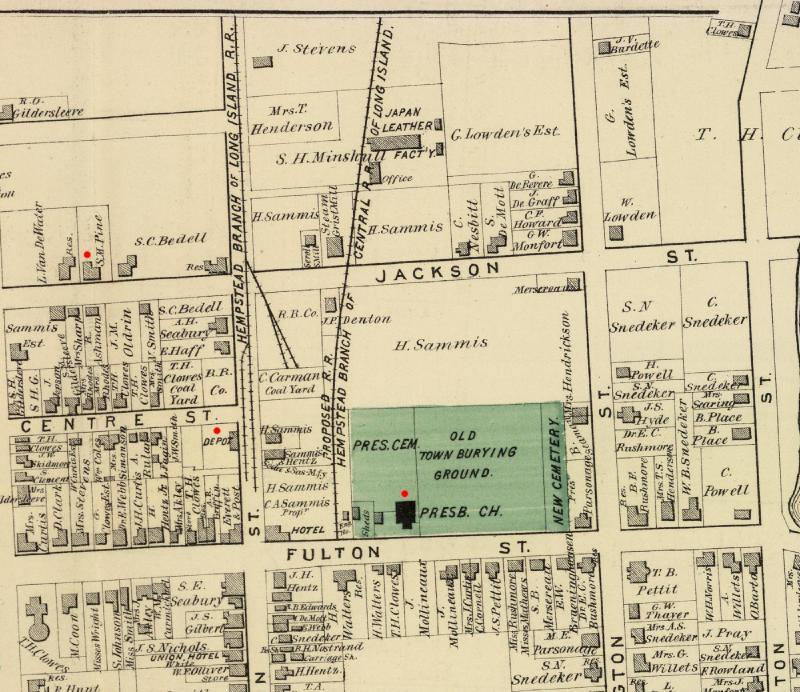
— 1873, F.W. Beers, Atlas Of Long Island, New York., p107-108, DavidRumsey.com. Cropped and highlighed in red. View largest available size.
The entire trip for Juliett to visit her grandfather, in five steps, would be approximately 30 miles, based on my best estimates using various maps, as well as distances given on railroad timetables:
| Start | End | Method | Approximate Distance in Miles |
|---|---|---|---|
| East 6th Street, NY | Whitehall Street, NY | wagon/coach | 3 |
| Whitehall Street, NY | Atlantic Street, Brooklyn | South Ferry | 1.5 |
| Atlantic Street, Brooklyn | Mineola Depot | LIRR | 20 |
| Mineola Depot | Hempstead Depot | Hempstead Branch LIRR “dummy train” | 2.5 |
| Hempstead Depot | Luther Loper’s farm | wagon/coach | 1.5 |
The ferries and the train from Brooklyn to Hempstead ran most days. Timetables from the early 1850’s consistently show that the trip from Brooklyn Depot to the Hempstead Depot on the LIRR was completed in approximately 90 minutes.

— 01 Oct 1852, from Hempstead, Arrts-arrchives.com. View largest available size.
Note that once we reach the start of the LIRR in Brooklyn, the route taken is precisely what we would expect Reverend Locke to have taken to his new Church in Hempstead, and it is also presumably how Edward returned to Hempstead from Staten Island in 1850 to marry Mary Ann (Pine) Mills, and this is how they returned together to visit their parents and siblings who remained in Hempstead. And this is part of the journey Emily Mills may have taken to visit her grandfather Jonas Davis Mills who lived just to the east of Christ’s First Presbyterian Church in Hempstead.
For Juliett, the journey to Hempstead seems to be a manageable trip that she may have taken to visit her grandparents, accompanied by her family, starting in 1848 when she was three years old until her grandfather Luther Loper died on 05 Apr 1856, when Juliett was 11 years and 3 months old. Her identification of Grandfather was presumably made many years later. (Does Martha have a sense of this, perhaps from the nature of her handwriting?)
Census records indicate that Luther’s wife Sarah moved to Staten Island shortly after Luther’s death to live with her daughter Elmira and son-in-law Charles M. Pine–Edward Mills’ mentor in business–at a time when Edward and Mary Ann were also living in Staten Island. Staten Island naturally seems to become a primary focus of Juliett’s family visits, and until she left New York after Erastus’ death, it would have been a much simpler trip than the one to Hempstead, via the Staten Island Ferry Terminus at Whitehall Street.
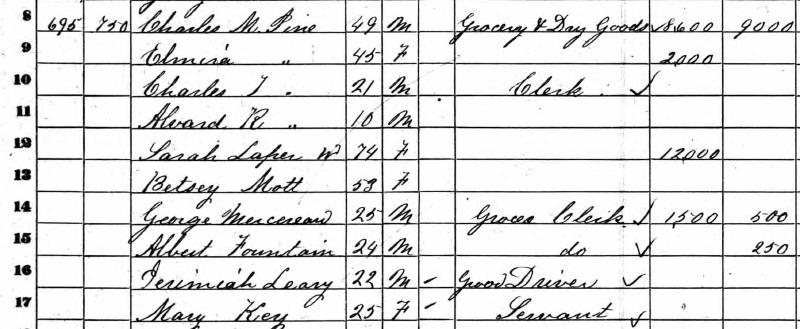
— 15 Jun 1860, United State Federal Census, Castleton NY, p96, ancestry.com. View largest available size.

LOPER–Jan. 6, at the residence of her son-in-law, Charles M. Pine, West Brighton, Staten Island, Mrs. Sarah Loper, widow of the late Luther Loper, aged 83 years, 1 month and 27 days.
Remains to be taken to Hempstead, L.I., by 10 o’clock train L. I. Railroad on Saturday, Jan. 8.
— 08 Jan 1870, New York Daily Tribune, New York NY, p?, fultonhistory.com. View largest available size.
Consider another possibility: if Juliett continued to visit relatives in Hempstead after Luther Loper’s death, then presumably she would have had more opportunities to interact with Reverend Locke, until he died in 1862. Obviously, her memories of these interactions would be those of an older child, more recent to her, and therefore, fresher in her mind in later years, even if she had fewer overall interactions with the Reverend compared to her grandfather.
Obviously, the Souvenir book was published several decades after Reverend Locke’s death, and so, we must consider the possibility of degraded memories with that as well. Yet the contexts are quite different: there were presumably a number of people still living and active in the Church in 1895 whose memories could be called upon and corroborated when compiling the book, and those memories would be based on much more interaction with the beloved pastor who was also very active in the community outside of his ministerial duties over a dozen years in Hempstead.
One such person is Edward Mills’ half brother Robert (11 Nov 1835 to 15 Jan 1912), who moved with the family to Hempstead when he was a small child and remained for many years, presumably living in Hempstead the entire time that Reverend Locke was minister. Robert was married to Esther Hinman (Losee), “both of Hempstead” on 21 Jul 1858 by Reverend Locke (1922, History and Vital Records of Christ’s First Presbyterian Church of Hempstead, Long Island, New York, Contributed by John Dean Fish, The New York Genealogical and Biographical Record, Volume 53, p257, Google Books.), and Robert and Esther are still listed as active members of the Church in the Souvenir book (p71). For more information on Robert Mills, see the Hempstead section.